If you’ve used ChatGPT Teams for marketing work, you probably know it’s a solid tool, but not without gaps. Maybe you’ve run into limits while collaborating on content, or the pricing doesn’t justify the value for your use case. That’s what happened with my team; we loved the quick answers but needed better workspace control, project tracking, and team access.
So, I tried out a bunch of ChatGPT Teams alternatives; looked through G2 reviews, tested them myself, and compared notes with other marketers. In this list, I’ll walk you through:
- Why you might want a ChatGPT Teams alternative for marketing.
- The best tools I found (and what they’re best at).
- What you can expect in terms of features, collaboration, and pricing.
Let’s break them down one by one.
TL;DR
- The best ChatGPT Teams alternative on the market is Team-GPT because it offers advanced team collaboration features and supports multiple AI models like GPT-4, Claude, and Mistral.
- Other tools like BrainChat.AI and Claude Teams are ideal for basic collaboration and user-friendly interfaces.
- On the other hand, if you’re looking for open-source flexibility or need to deploy models locally, DeepSeek and Perplexity Enterprise Pro are worth exploring.
Why Do You Need a ChatGPT Teams Alternative in the First Place?
ChatGPT Teams works well if your team is already familiar with ChatGPT and just needs shared access to GPT-4o. You get a centralized billing setup, basic workspace management, and slightly higher usage limits compared to the Plus plan. It’s a decent choice for small teams who want to get started quickly without juggling multiple accounts.
But once you start using it for real collaboration, especially in a marketing workflow, it starts to feel limiting. Here are some problems that I saw the tool has:
Reason 1: Limited Collaboration Features
The “shared workspace” sounds useful, but it’s not what you’d expect. You can’t actually collaborate in the same conversation or edit AI chats together. If you’re working in a marketing team, this makes real-time collaboration harder than it should be.
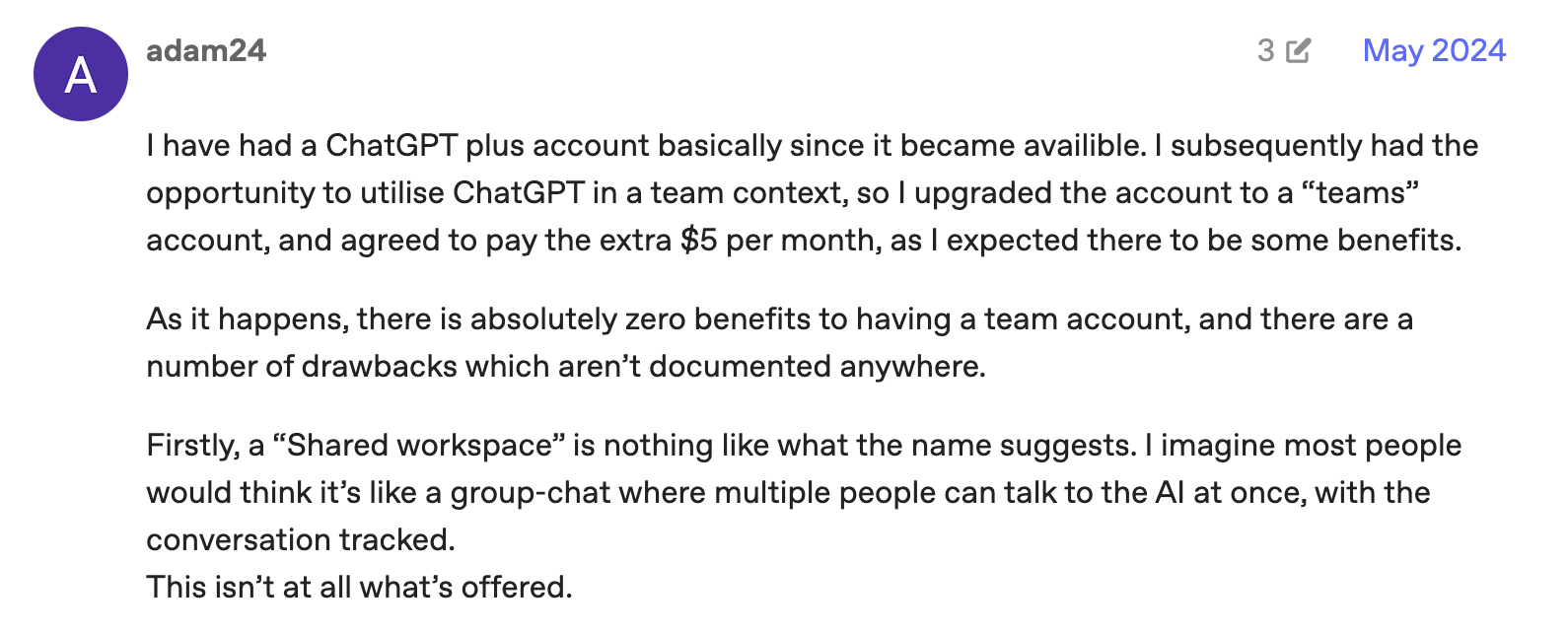
Reason 2: High Cost With Little Extra Value
The Teams plan costs more than Plus, but the benefits don’t scale with price. You do get more GPT-4 usage (160 messages vs. 80), but for many marketing teams, that’s not worth the extra cost, especially when collaboration is still limited.

Reason 3: You Lose Access to Useful Features
Once you move to Teams, you can’t train the model on your chats, export your data, or access newer features early. If you downgrade, you lose all your old conversations. If your work involves research or step-by-step prompting, this can be a real issue.
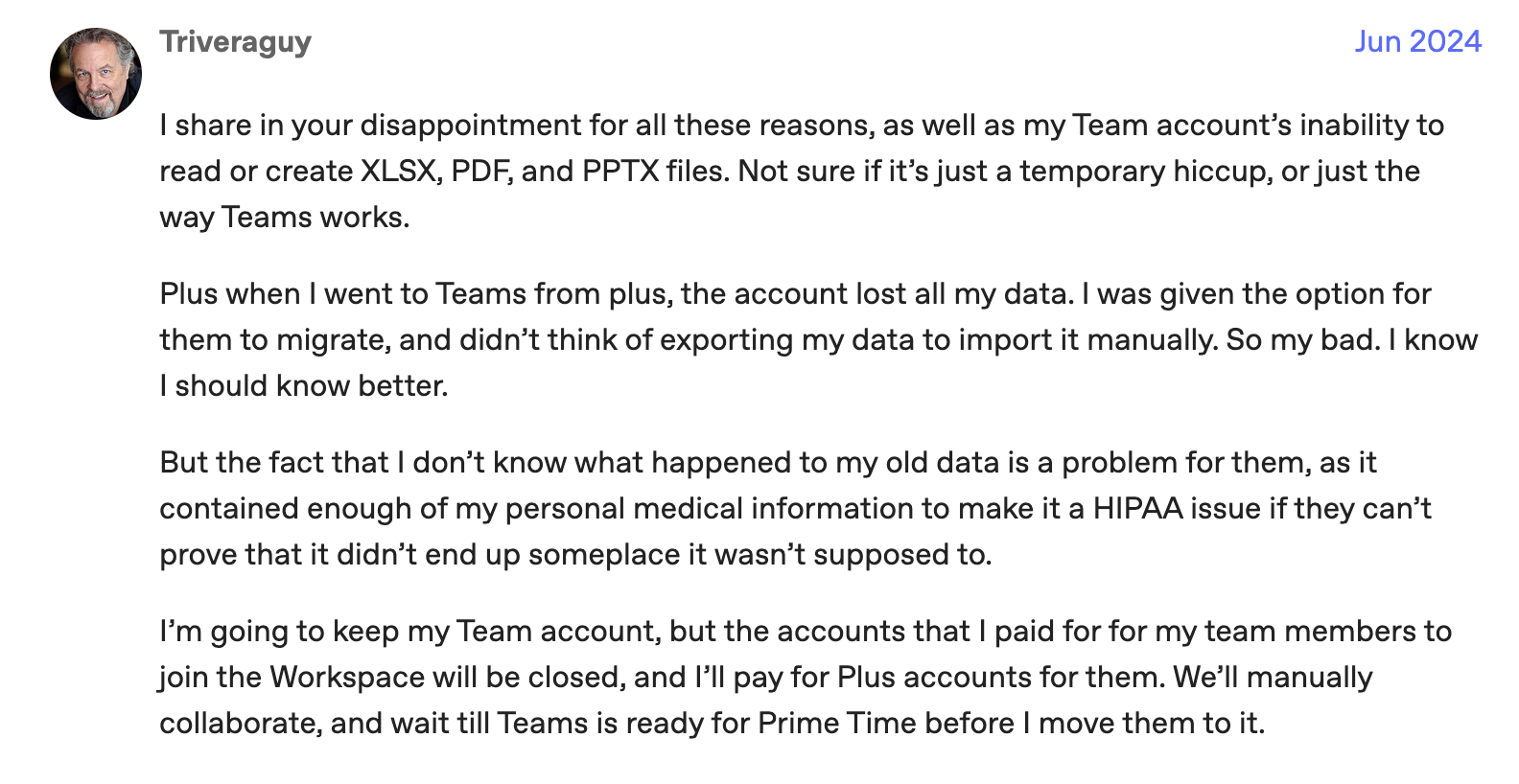
Reason 4: Privacy and Access Controls
Any team member can invite others, which risks bloating your bill. At the same time, you can’t share chats outside the workspace or easily loop in freelancers or clients. For marketers juggling internal and external teams, this setup can create real bottlenecks.
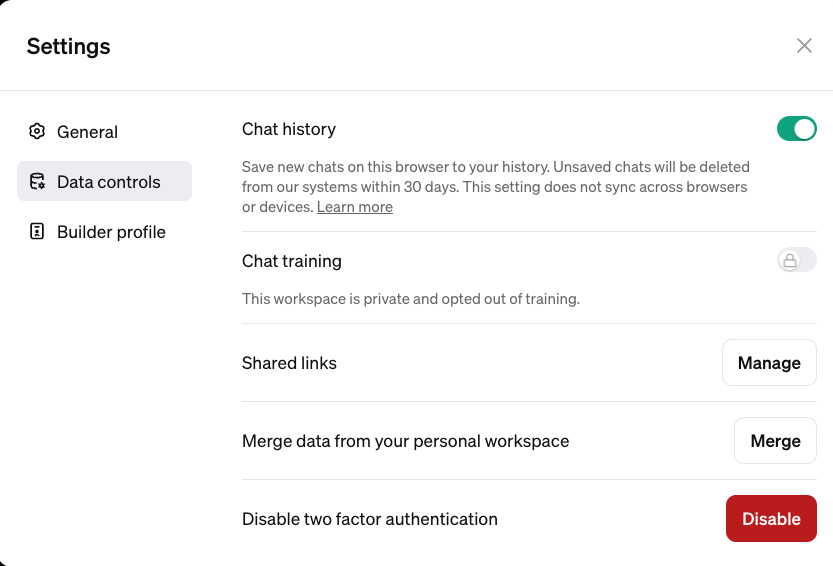
Reason 5: Lack of Transparency
OpenAI hasn’t clearly explained the limitations of the Teams plan. You won’t find detailed documentation on what’s included or missing. For example, Teams accounts currently can’t generate Excel or PDF files in some setups. These issues aren’t made clear upfront, and support isn’t always responsive.

What Are the Best ChatGPT Teams Alternatives and Competitors in 2025?
Here is an in-depth summary of the 10 best ChatGPT Teams alternatives for Marketing and their best features:
1. Team-GPT
Team‑GPT is a multi-model AI workspace built specifically for teams that want more control, structure, and collaboration than what basic chat tools offer. It supports GPT‑4o, Claude, Gemini, and other top models in a single interface, giving you flexibility to choose the right model for each task.
You can create shared prompt templates, co-edit chats, generate images inside threads, and track performance through detailed usage analytics.

Full disclaimer: Even though Team-GPT is our platform, I’ll provide an unbiased perspective on why it will be the best ChatGPT Teams alternative for Marketing in 2025.
Feature #1: Build a Marketing Workspace That Fits Your Brand
Team‑GPT gives marketing teams full control over how they work with AI. You can integrate multiple top-tier models (GPT-4o, Claude, Gemini, Mistral, or even your own via API), allowing teams to choose the right model for each task.
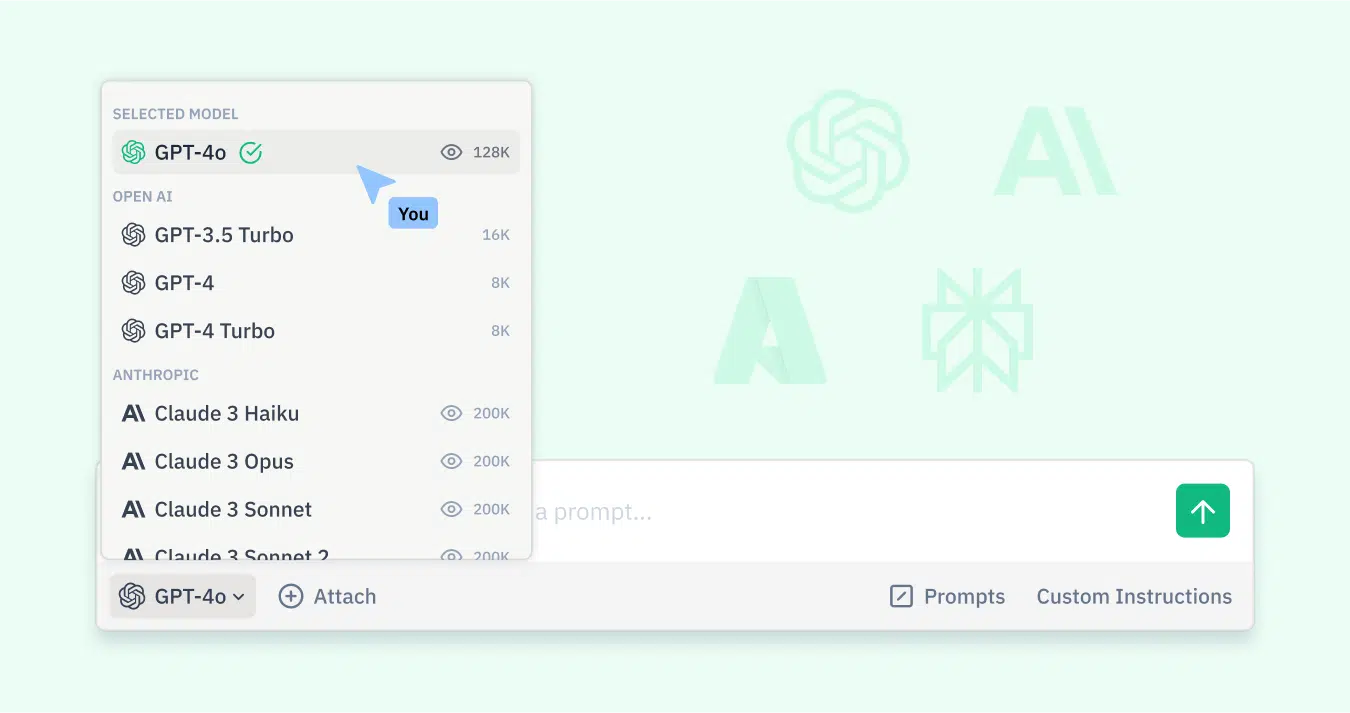
Moreover, structured prompt templates ensure consistent messaging across use cases, whether for SEO, ads, email, or product pages. Shared libraries and reusable tone instructions also help maintain voice across campaigns, keeping everyone aligned and on-brand without duplicating effort.
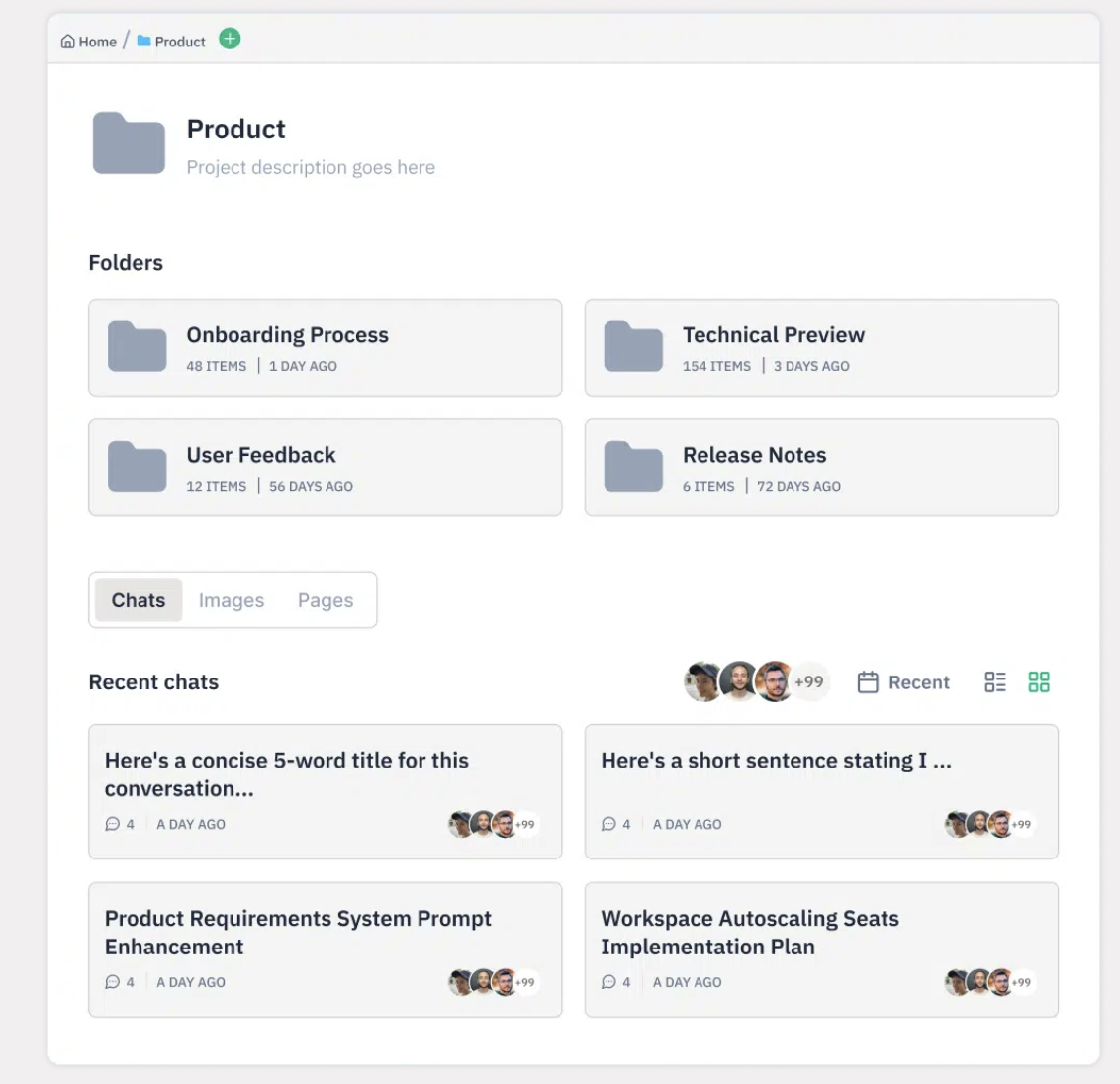
Feature #2. Usage Analytics to Track Impact
Unlike tools that stop at chat history, Team‑GPT offers real-time analytics on team activity and performance. You can see which prompts are used most, which models produce the best results, and how AI adoption trends evolve across your campaigns.
This helps marketing leaders identify prompt effectiveness, optimize workflows, and spot underutilized capabilities. Insights are actionable, visualized, and role-based, helping both strategists and team leads.
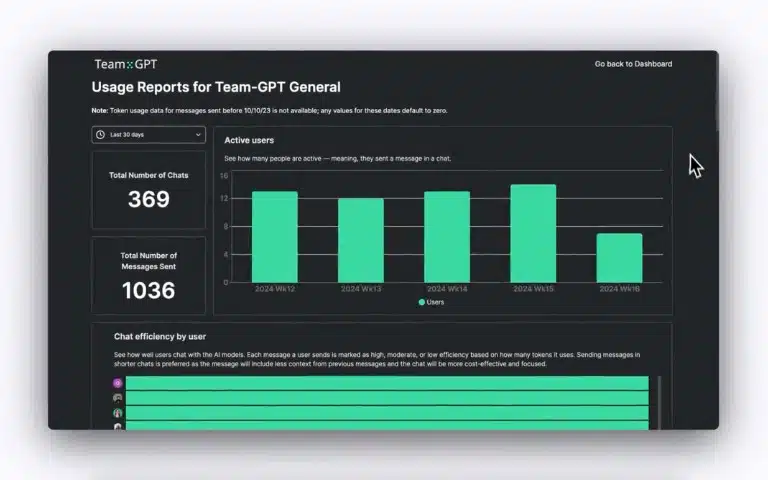
Feature #3. Generate Images with DALL·E 3 Inside Chat
Team‑GPT lets you create AI-generated images right inside your chat threads—ideal for producing blog headers, product shots, or quick visual ideas during brainstorming. There’s no need to switch tabs or interrupt workflows. Writers and designers can align creative direction without friction, ensuring consistent, on-brand visuals from ideation to delivery.
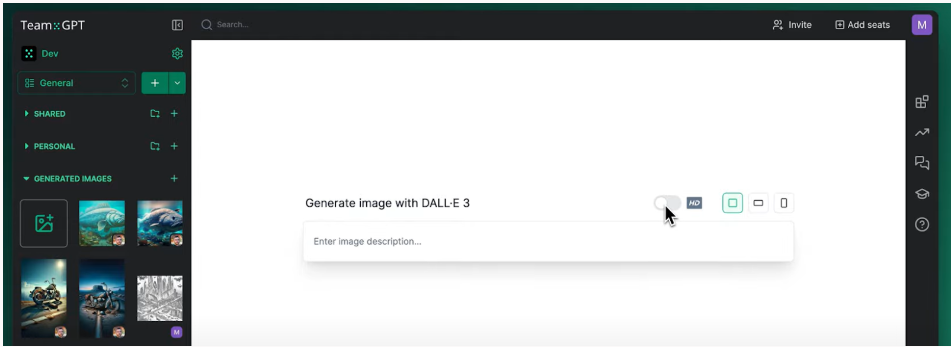
Feature #4. Enterprise-Grade Security & Control
Whether you’re a regulated company or a privacy-conscious agency, Team‑GPT supports enterprise-class security, including:
- Private cloud or on-premise hosting.
- Role-based access, workspace isolation, and SSO.
- Full SOC2, ISO27001, and GDPR compliance.
With custom deployment options and audit trails, it’s ready for teams that handle sensitive content or client data.
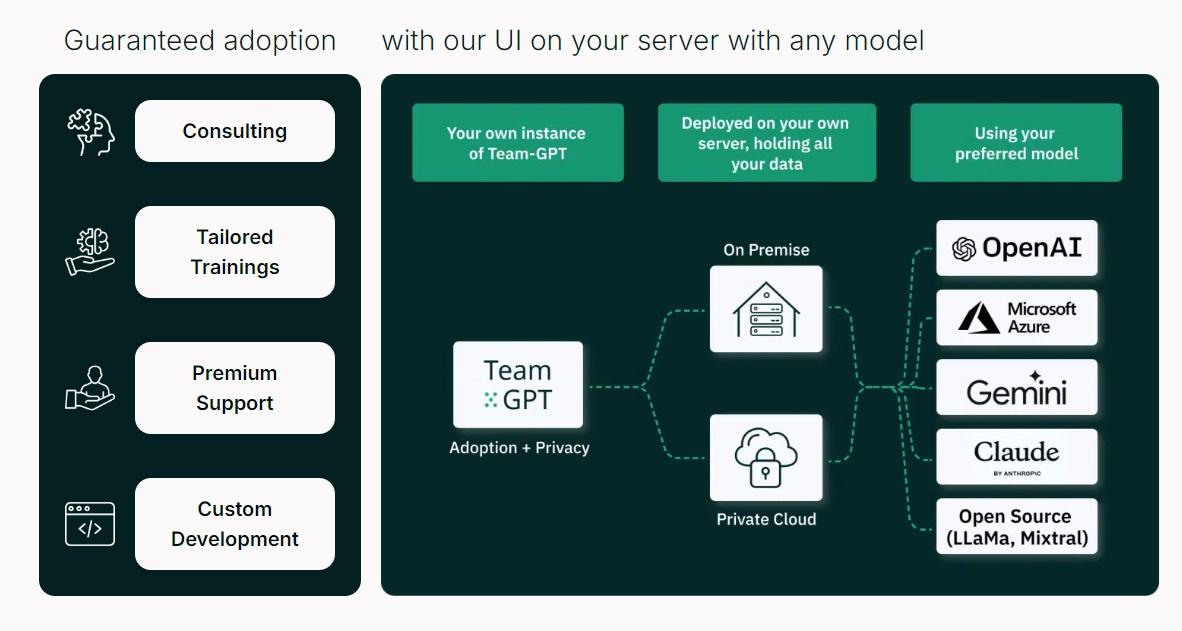
Feature #5. Purpose-Built for Team Collaboration
Team‑GPT isn’t just multi-user; it’s truly collaborative. Teams can co-create prompts in real time (like Google Docs for AI), fork chat threads to test alternate angles, and share outcomes for feedback, all inside a centralized workspace. Chats, prompts, and campaigns can be organized into folders, and new hires can get onboarded through shared knowledge bases. You can even assign AI learning paths for continuous upskilling.
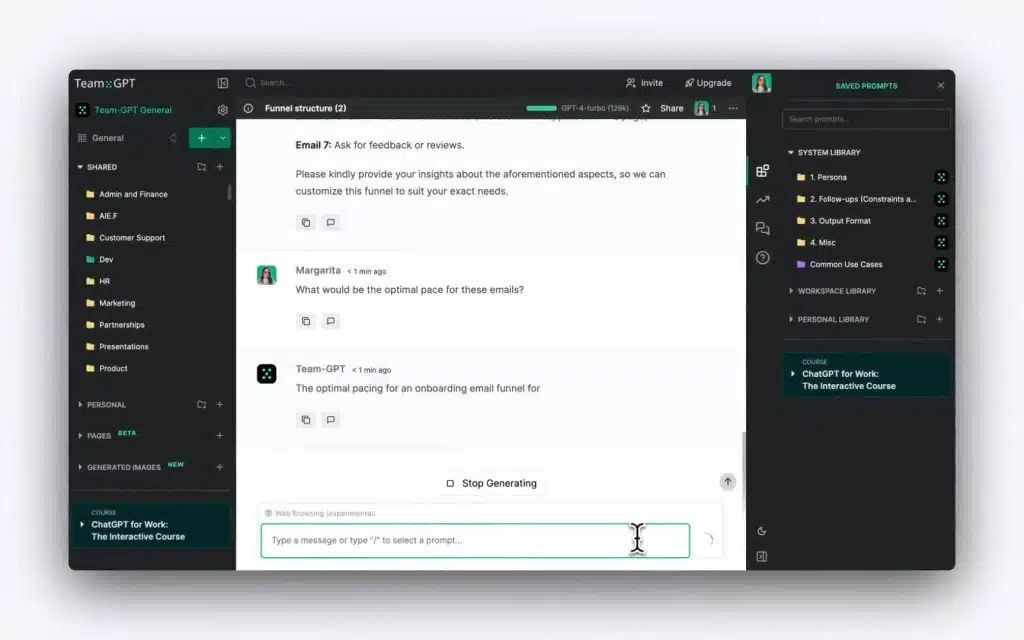
Pricing
Team-GPT offers three pricing plans tailored for growing marketing teams:
- Business Plan: $25 per user per month (billed annually, minimum 5 users). Includes:
- Multi-model access (GPT-4, Claude, Gemini, etc.)
- Shared workspace and folder structure.
- Prompt templates and usage tracking.
- In-chat image generation.
- Support and onboarding resources.
- Growth Plan: $35 per user per month (billed annually). Adds:
- Unlimited model usage.
- BYO API keys (for cost control).
- Access to Gemini, DeepSeek, and Perplexity.
- Advanced analytics and dashboards.
- Workflow integrations and prompt packs.
- Premium onboarding.
- Enterprise Plan: Custom pricing (150+ users). Includes everything in Growth plus:
- Private/on-prem deployment.
- Custom model integrations.
- Dedicated support.
- Admin and audit tools.
- Unlimited workspaces.
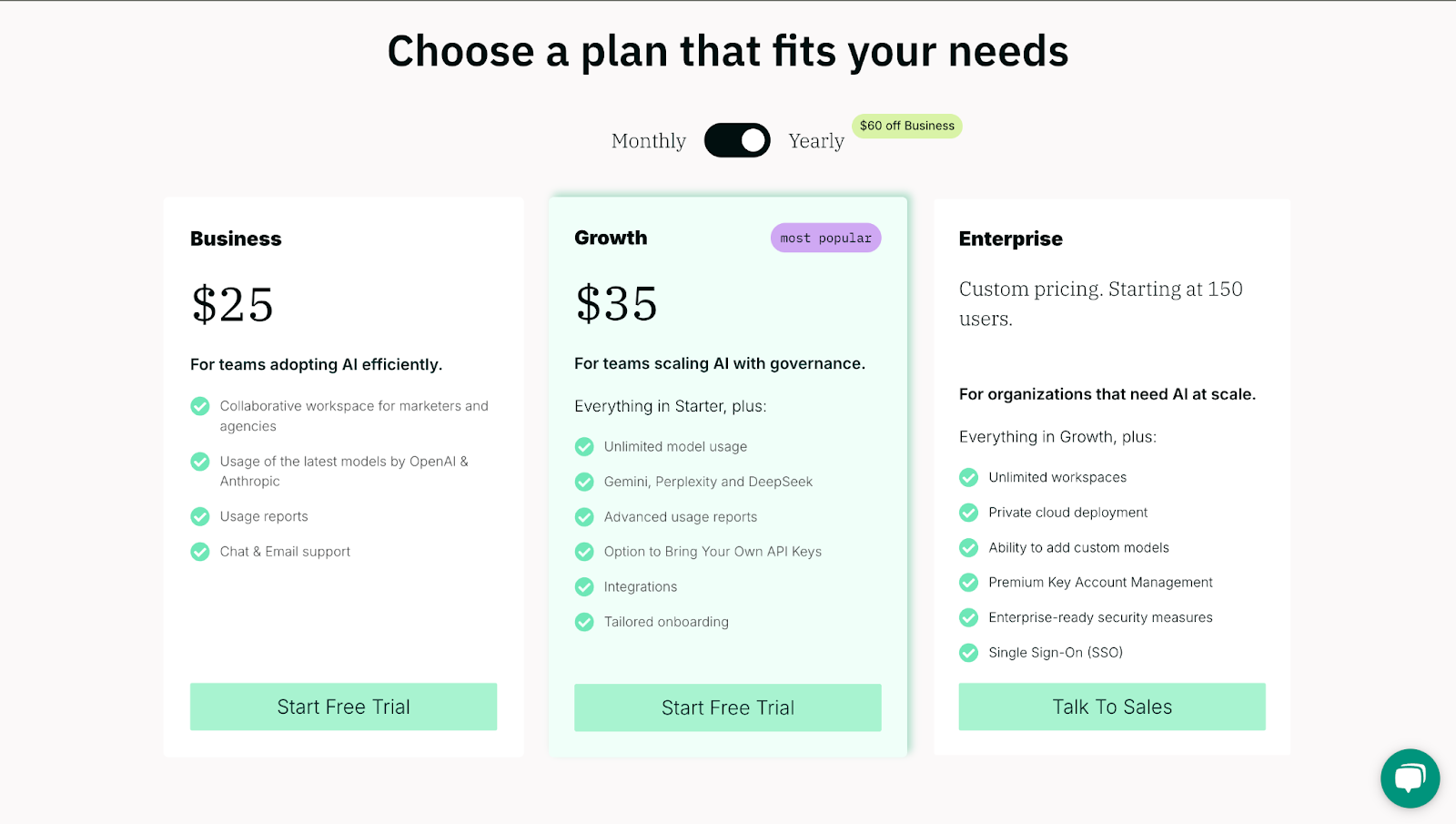
Pros and Cons
✅ Supports multiple top-tier AI models in a single workspace.
✅ Built-in visual generation using DALL·E 3 for cohesive content workflows.
✅ Strong admin controls, user analytics, and usage insights.
✅ Designed for real-time collaboration with shared prompts and chat forking.
✅ Enterprise-level deployment options ensure security and compliance.
❌ Web-only (no mobile or desktop apps yet).
❌ May feel too robust for teams that only need basic chat or solo usage.
❌ Slight learning curve if you’re not familiar with structured workflows.
How does Team-GPT compare to ChatGPT Teams?
Team‑GPT outperforms ChatGPT Teams in collaboration depth, workflow customization, and model flexibility.
- While ChatGPT Teams locks users into GPT-4 and offers limited shared features, Team‑GPT supports multiple models and real-time co-editing, which lets your team compare responses, split off brainstorming threads, and track what’s working across campaigns.
- Where ChatGPT Teams focuses on ease of use within OpenAI’s ecosystem, Team‑GPT focuses on long-term productivity, cross-functional alignment, and AI governance, making it a better fit for marketing teams that need structure, scale, and strategic insight.
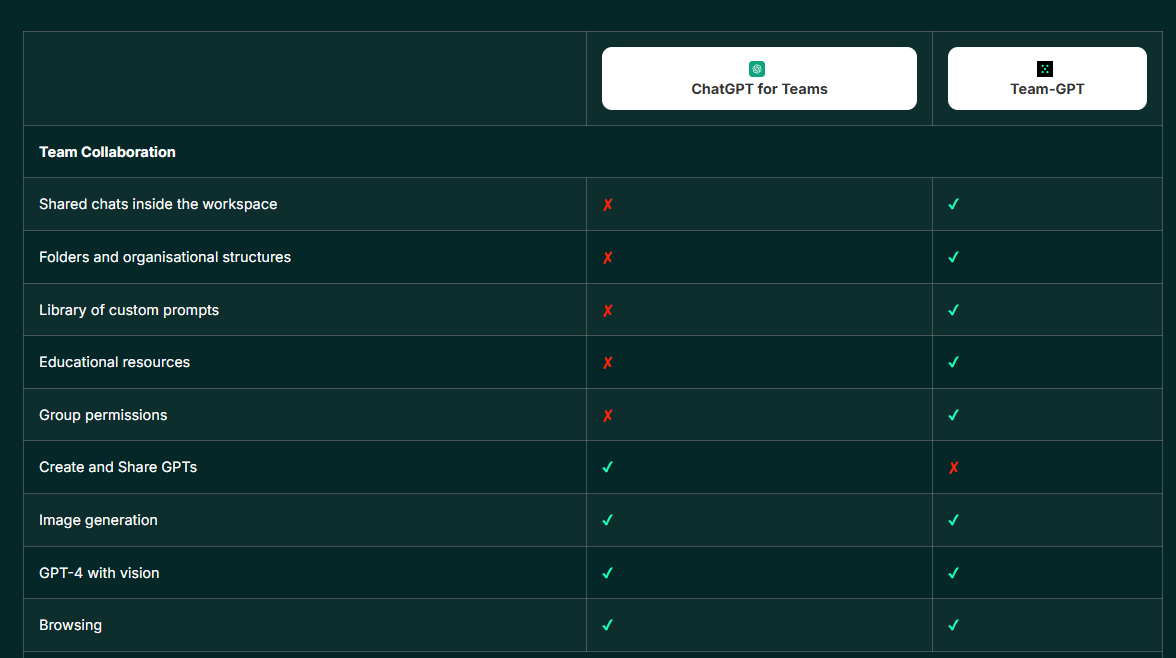
2. Perplexity Enterprise Pro
Best for: Mid-sized to large marketing teams that need fast, secure access to both internal content and external sources for campaign planning, messaging, and competitive research.
Similar to: Team-GPT, Jasper, Magai, and Glean.
Who’s it for: Marketing teams that spend a lot of time gathering research, summarizing documents, or preparing campaign reports.
Perplexity Enterprise Pro is designed to help marketing teams move faster by reducing the time spent searching for information. It brings everything—web data, internal decks, PDFs, research reports—into one searchable space.
Unlike standard AI tools that work mostly on prompts, Perplexity feels more like a shared research assistant that works across your team’s knowledge base and the live web. If your team spends a lot of time summarizing industry reports, checking competitor updates, or writing strategy docs, this platform helps reduce the manual effort.

Perplexity Enterprise Pro’s Top Features
- Live Web and Internal File Search: Ask complex marketing questions and get answers from both your documents and the web. You can upload campaign briefs, strategy decks, or market research reports, and the AI will pull insights from both your content and trusted online sources.
- Cited Answers for Everything: Every output includes links to the source. This is helpful when you’re preparing reports, executive summaries, or content that needs to be fact-checked.
- Custom Team Spaces: You can create private workspaces where your team can store files, organize research, and collaborate on marketing projects. It keeps your AI outputs, files, and references all in one place.
- Supports Charts, Images, and Files in Output: If your team needs visual outputs (like trend charts or image-based inspiration), Perplexity handles this in the same thread—so you don’t need to switch between tools.
- Role-based Access and Admin Controls: You can manage who sees what. Great for larger teams or agencies working across different clients or departments.
- Voice Support and Custom Prompts: You can speak to it during meetings, or build your own prompt templates for common tasks like “summarize this campaign deck” or “compare competitor messaging.”
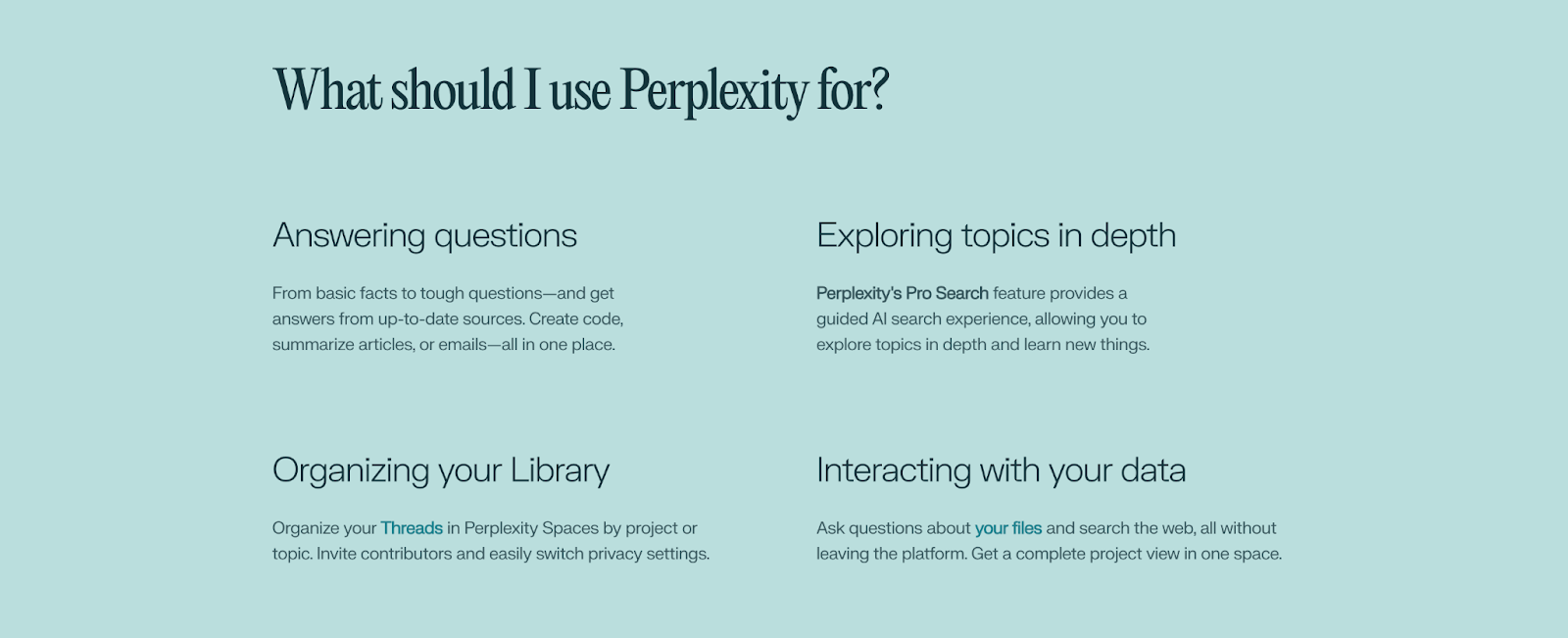
Pricing
Perplexity Enterprise Pro is priced at $40/month per seat ($400/year per seat, billed annually) for teams that rely heavily on research, collaboration, and access to both internal and external knowledge. It includes:
- Unlimited searches.
- Web + internal file analysis.
- Team workspaces and admin controls.
- Custom prompts and voice input.
- API access is available, billed separately (pay-as-you-go).
Note: There is no “pause” option; auto-renews by default, so you’ll need to cancel manually if needed.
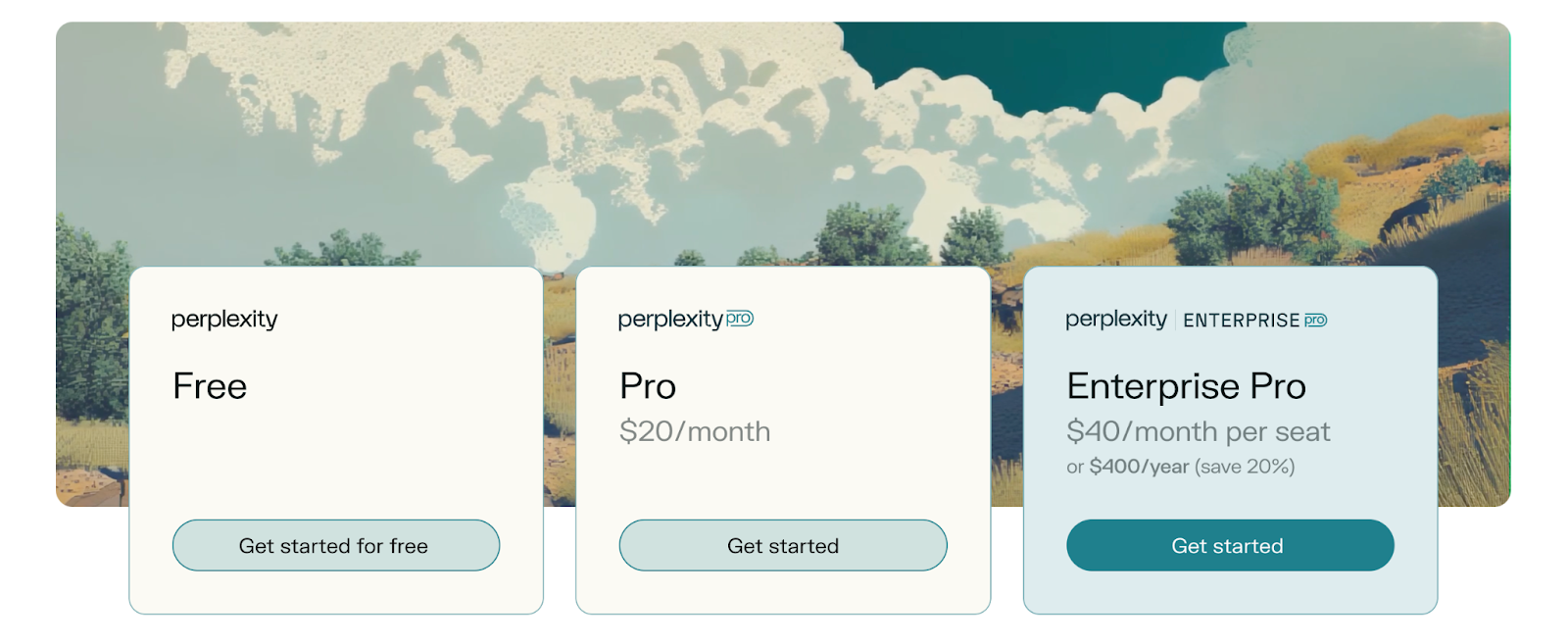
Pros and Cons
✅ Speeds up campaign research and content planning by summarizing documents, trends, and competitor data in minutes.
✅ Brings all your team’s research, reports, and decks into one searchable place.
✅ Helps your team work together on campaign ideas, messaging, or reports inside shared spaces.
❌ Doesn’t create design assets—you’ll still need to use Canva, Figma, or another tool for visuals.
❌ Some parts of the UI (like project folders or collections) could be smoother.
3. Claude Teams
Best for: Document-heavy projects and team-based content creation.
Similar to: Microsoft Copilot, Notion AI, ChatGPT Teams.
Who it’s for: Marketing teams that work with long documents, brand-specific content, and prefer structured collaboration.
If your team regularly works with long strategy docs, campaign decks, or legal and product material, Claude Teams might be a good fit. It’s designed for structured, project-based collaboration, where multiple teammates can work together on chats, content, and files, all in one place. I found it especially useful when I needed to brainstorm inside a team workspace, get context-specific responses, and generate documents without having to switch tools.
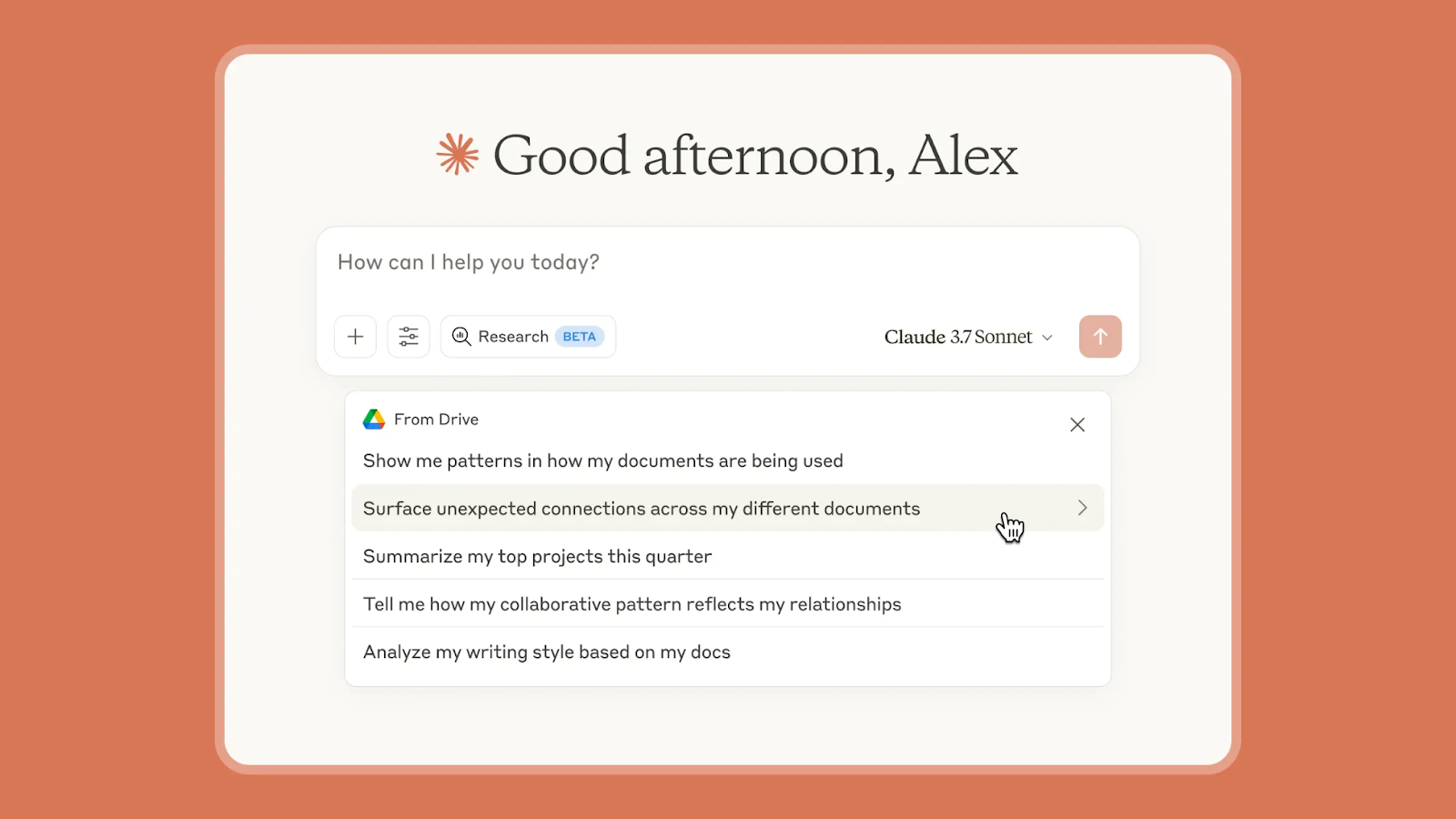
Claude Teams’ Top Features
- Project Workspaces: You can create separate projects for campaigns, clients, or product areas. Inside each project, you can upload documents and brand assets. Claude uses this context to give relevant, grounded responses.
- Team Collaboration: Multiple people can co-chat with Claude in real time, share files, and edit AI-generated content (called “artifacts”) directly within the workspace. These artifacts can be docs, tables, or code blocks.
- Context Memory (200K tokens): Claude can handle long content without breaking it up. I’ve used it to analyze campaign reports, legal docs, and product specs in one go, without losing context mid-way.
- Role-Based Responses: You can ask Claude to take on a specific role, like “speak like a brand marketer” or “review as a legal advisor,” per project. This helps when you need content reviewed or rewritten for a specific audience.
- Early Access & Admin Tools: You get priority access to new features, centralized billing, and admin controls, helpful if you’re managing a larger team.
- Security & Privacy Controls: Role-based access, permissions, and data privacy features make it suitable for teams working with sensitive content.
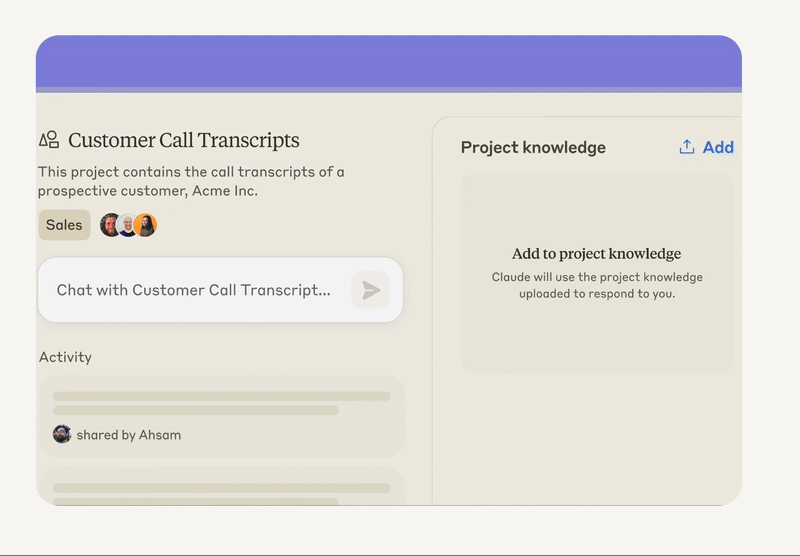
Pricing
Claude Teams is priced at $25 per user per month (billed annually) for a minimum of 5 users. It offers a single, straightforward plan with a few enterprise-oriented benefits, such as:
- More usage than Claude Pro users.
- Access to Claude 3.5/4 models with a 200K-token context window.
- Admin tools for access and billing control.
- Centralized Projects and collaboration features.
- Early access to new features and priority system access.
Note: A monthly billing option is also available at $30 per user.
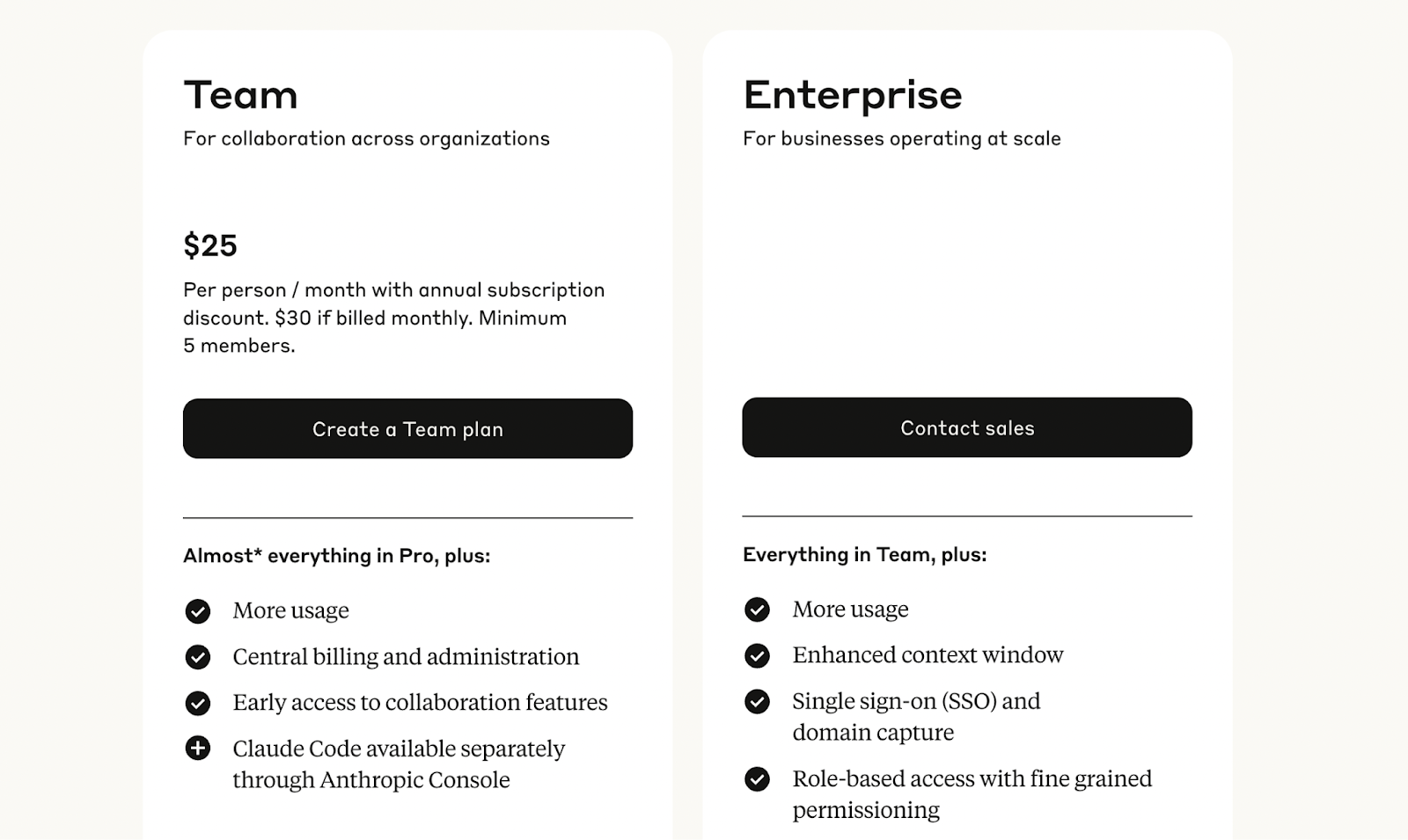
Pros and Cons
✅ Makes it easy for multiple team members to collaborate inside shared project workspaces, which helps keep campaign discussions and assets in one place.
✅ You can assign roles to Claude, like reviewing a campaign as a legal advisor or writing ad copy as a marketer, making responses more context-specific.
✅ Admins can manage access, billing, and permissions through a single dashboard, which is helpful for fast-growing teams.
❌ It’s not ideal for casual, free-form collaboration or real-time back-and-forth across many threads.
❌ Doesn’t support image or design generation, which limits its use for visual marketing tasks.
4. BrainChat.AI Enterprise
Best for: Marketing teams that want model variety, more control over data, and better collaboration tools than what ChatGPT Teams currently offers.
Similar to: ChatGPT Teams, Jasper, Claude Teams.
Who’s it for: Small to mid-sized teams in marketing, sales, or content who want a cost-effective and privacy-friendly AI workspace.
If you’re looking for an AI collaboration tool that goes beyond just GPT, BrainChat.AI is worth checking out. You get access to multiple AI models like GPT-4, Claude, Gemini, DeepSeek, and others, all in one place. You can collaborate with your team in real time, organize chats into folders, and manage user roles.
What stands out is the control it gives you over your data and how your team uses AI. You also get flexible pricing, quick customer support, and an easy way to import your existing ChatGPT chats.

BrainChat.AI’s Top Features
- Multiple AI models: Switch between GPT-4, Claude, Gemini, Mistral, DeepSeek, etc., based on the task.
- Real-time collaboration: Share chats, create AI agents, and manage team access across shared folders.
- Admin and privacy controls: You decide how your team uses AI and where the data goes; nothing is stored or used for training unless you allow it.
- Import/export: Bring in your ChatGPT chats or export results for reporting.
- Responsive support: Quick replies (often within 24 hours) and options for 1:1 calls.
- Pay-as-you-go pricing: You only pay for what you use, which works better for teams that want to manage budgets closely.

Pricing
BrainChat.AI offers three pricing plans for you to choose from:
- Starter ($7 per user per month): Best for small teams and offers a collaborative workspace, access to the latest OpenAI models, and the ability to share chats and use 3 AI agents.
- Business ($10 per user month): Built for growing teams that need broader capabilities. Includes everything in Starter, plus unlimited model access, integrations and tailored onboarding, 20 AI agents and unlimited prompts.
- Enterprise (Custom pricing): Tailored for large organizations needing tighter security and scale. Includes everything in Business, plus unlimited workspaces, option to use your own API keys, private cloud deployment and custom models.
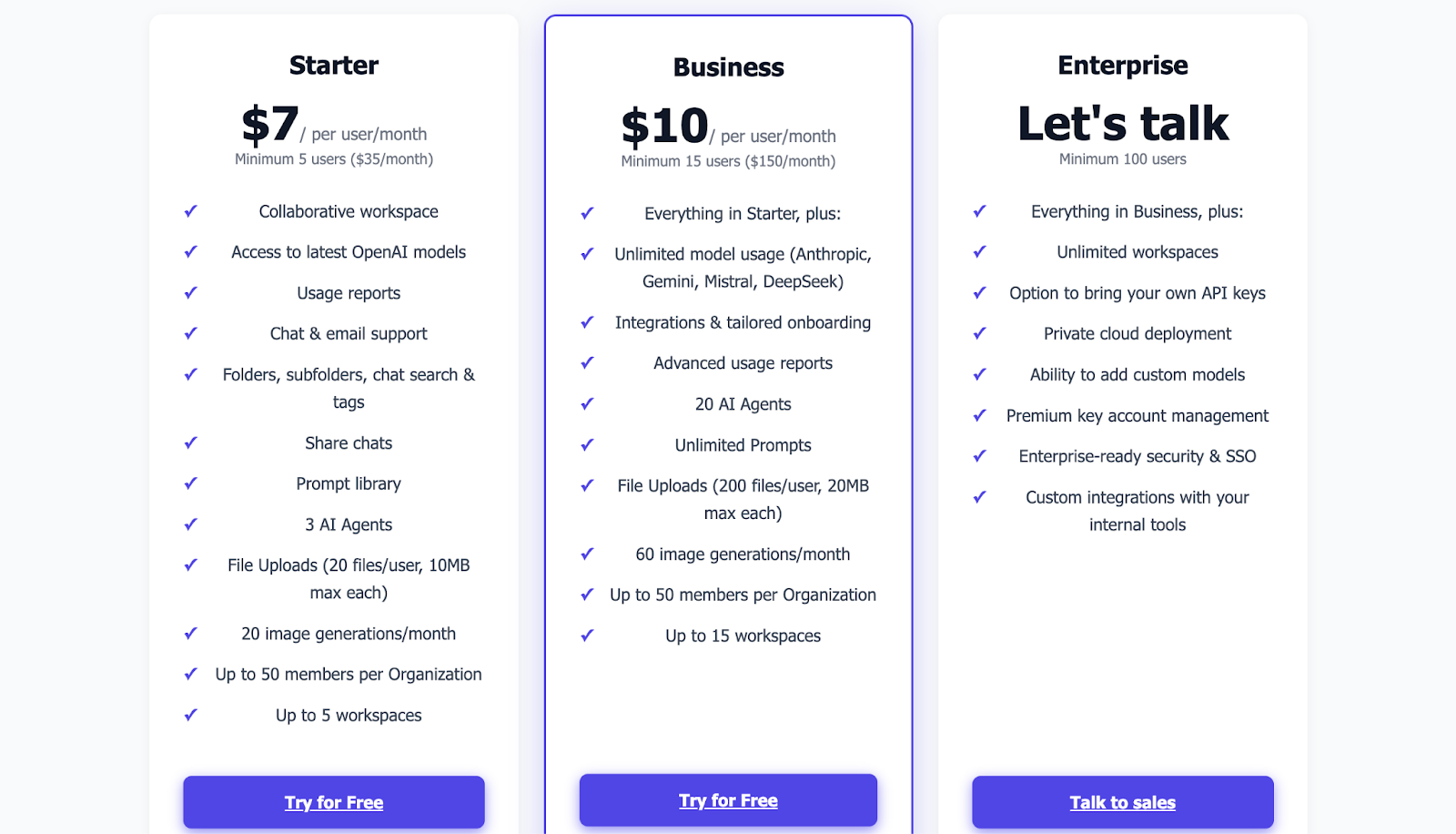
Pros and Cons
✅ You get access to multiple AI models, including OpenAI, Claude, Gemini, DeepSeek, and Mistral, under one interface.
✅ The platform supports real-time collaboration through shared folders, chats, and AI agents.
✅ It gives admins control over usage, access, and data sharing, ensuring privacy and compliance.
❌ The platform doesn’t currently include built-in design or visual content generation tools.
❌ While it’s feature-rich, it’s still evolving and may have minor UI or UX limitations.
5. Microsoft Copilot
Best For: Marketing teams of all sizes already using Microsoft 365 who want AI support embedded directly into the tools they work in every day.
Similar To: Deepseek, Claude Teams, Google Gemini.
Who’s It For: Mid-sized to large marketing teams working across documents, presentations, emails, and spreadsheets.
Microsoft Copilot is a generative AI assistant built into Microsoft 365 apps like Word, Excel, PowerPoint, Outlook, and Teams. It supports marketing teams by helping them create content, analyze campaign data, automate follow-ups, and stay on track with shared tasks within the tools they already use. It combines AI with internal data and real-time web insights to provide contextual suggestions and save time across marketing workflows.
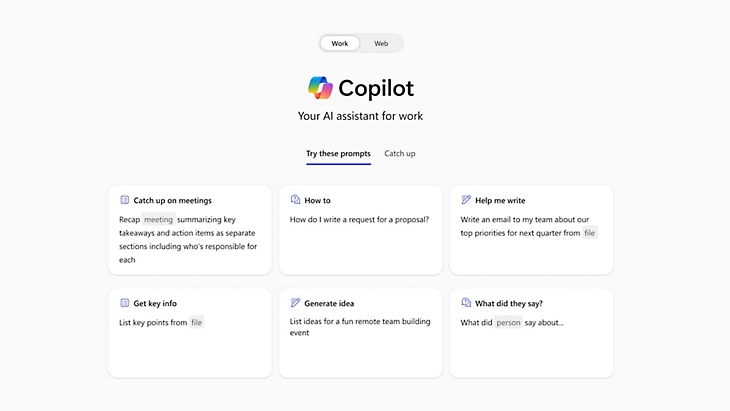
Microsoft Copilot’s Top Features
- Content creation inside apps: Write social posts, emails, blog drafts, and slides directly in Word, Outlook, or PowerPoint using natural language prompts.
- Data analysis in Excel: Ask plain questions about campaign results, get insights, charts, and reports without manual formulas.
- Meeting summaries in Teams: Copilot creates follow-ups, task lists, and highlights from marketing meetings automatically.
- Automate repetitive tasks: Schedule meetings, track deliverables, send follow-ups, or allocate resources, without needing extra tools.
- Real-time insights: Pull in external web trends and your internal documents to get current competitor analysis or campaign performance updates.
- Custom AI agents (Copilot Studio): Build role-specific AI helpers, like a chatbot for campaign brainstorming or a content calendar manager.
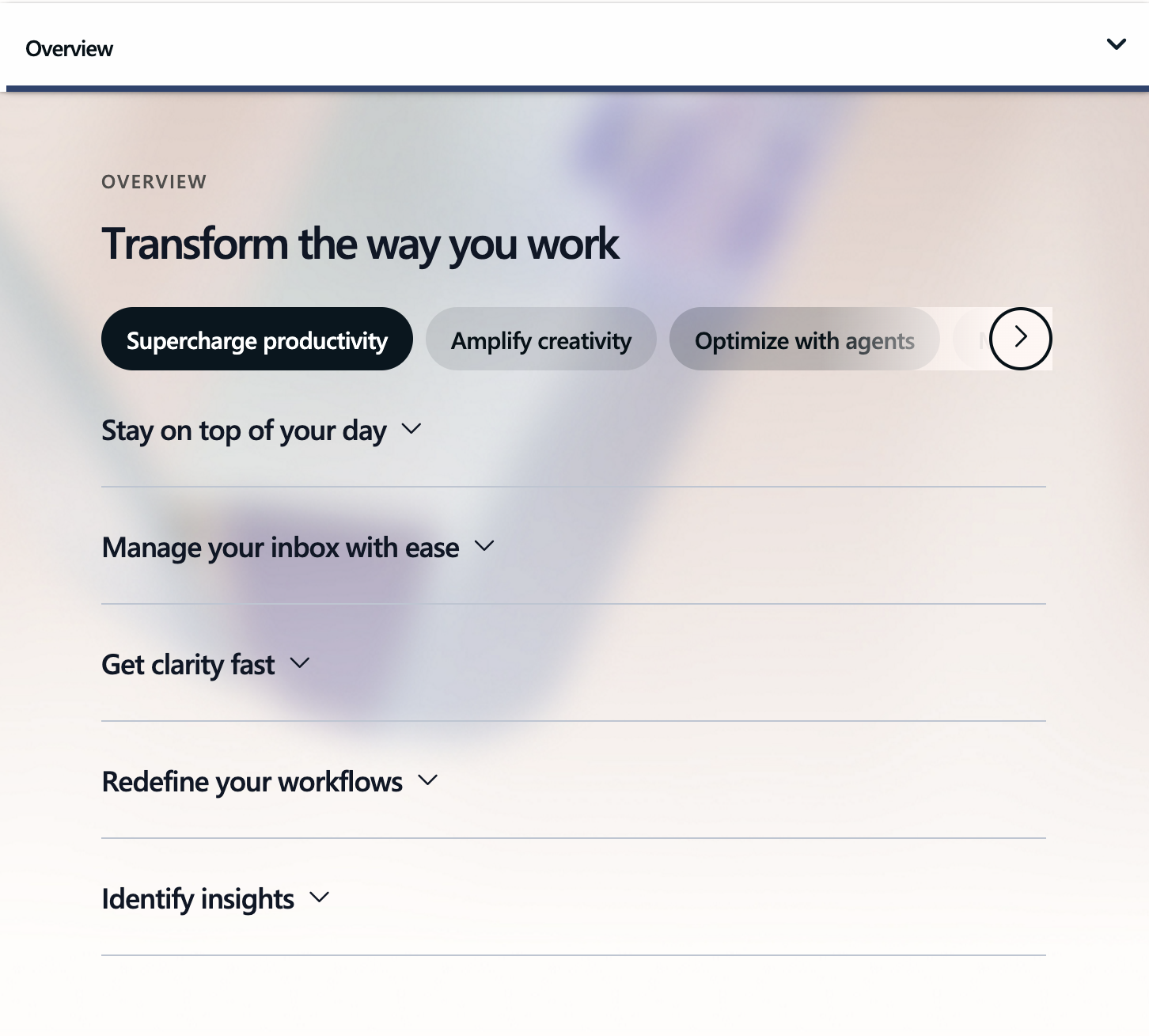
Pricing
Microsoft Copilot offers several plans based on your team’s needs:
- Copilot Pro ($20 per user/month): Advanced AI features in Word, Excel, and PowerPoint (web versions only).
- Microsoft 365 Copilot for Business ($30 per user/month: Full integration with Microsoft 365 apps, collaboration tools, and workflow automation.
- Enterprise Plan ($30 per user/month): Includes everything in Business, plus admin controls, compliance tools, and custom AI agents.
- Copilot Studio ($200/month): Build and manage your own AI agents tailored to your team’s workflows.

Pros and Cons
✅ Works directly inside the tools you already use; there is no new platform to learn.
✅ Speeds up everything from content drafts to campaign reporting.
✅ Lets you create AI agents for specific marketing tasks or team roles.
❌ Can get expensive for small teams, especially without Microsoft 365.
❌ You’ll still need a separate tool for design or visual content.
6. Magai
Best for: Marketing teams that want all their AI tools, content workflows, and project collaboration in one place.
Similar to: Merlin, Writesonic, BrainChat.AI
Who’s it for: You’ll benefit from Magai if you’re part of a marketing team that works across departments, runs multiple campaigns, and wants to avoid switching between tools.
Magai Team gives you one shared platform to handle all your marketing content, campaign planning, and collaboration tasks. Instead of bouncing between different AI tools, file-sharing apps, and task boards, you can manage everything from a single workspace.
You get access to over 40 AI models like ChatGPT, Claude, Gemini, and DALL·E, so whether you’re writing, designing, analyzing data, or doing research, you’ll have the right AI for the job.
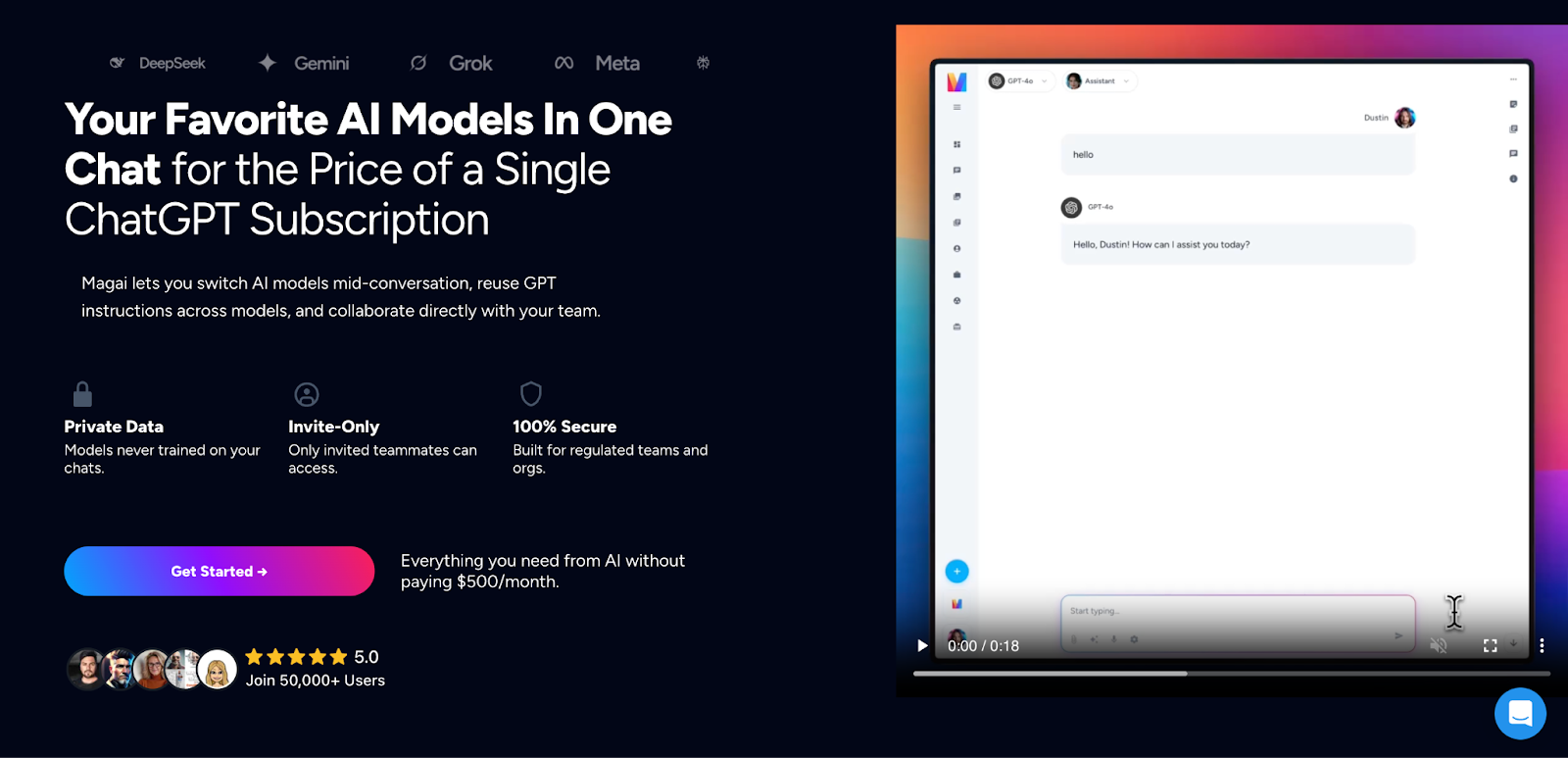
Magai’s Top Features
- Multi-AI Access in One Platform: Use ChatGPT, Claude, Gemini, DALL·E, and more from a single interface for writing, image generation, and analysis tasks.
- Workspaces & Organization: Set up different spaces for teams, projects, or departments. Everyone stays organized while still being able to collaborate.
- Real-Time Team Chat: Chat live with teammates inside Magai while using AI together; there is no need to switch between apps.
- Prompt Templates: Save and reuse prompt formats so your outputs stay consistent across different team members and campaigns.
- Search & Folders: Tag, search, and organize chats and content, so you don’t lose useful outputs or repeat work.
- Webpage Insights: Share links and let Magai read the page in real-time to pull insights into your campaign or research.
- File Uploads: Upload documents and get summaries, suggestions, or content directly from the files.
- AI Personas: Use pre-built AI roles (like content strategist or market analyst) that help you keep brand tone and task focus aligned.
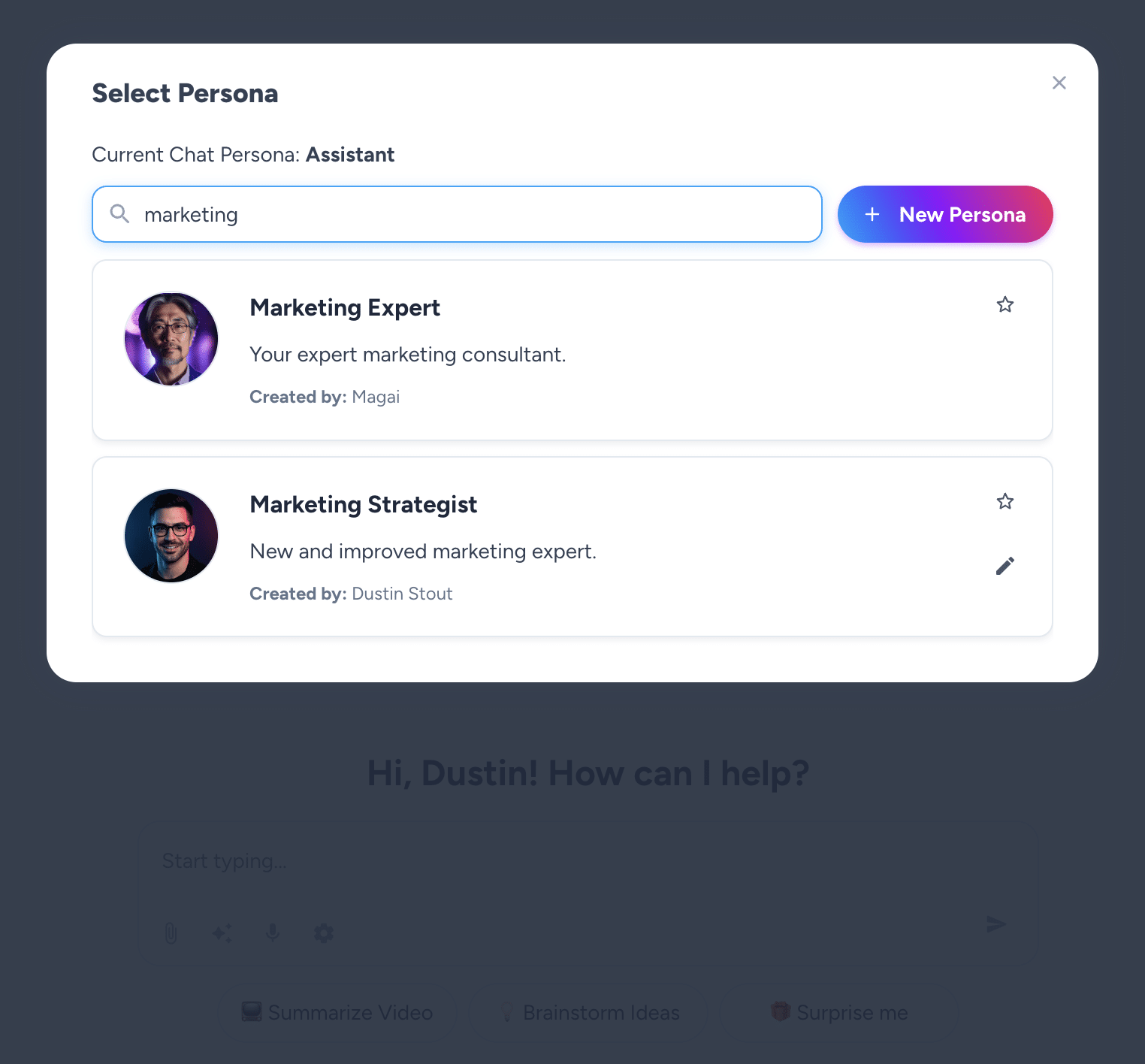
Pricing
Magai Team is priced at $40 per month (billed monthly) and includes:
- Access to all premium AI models and tools.
- 3x more usage than individual plans.
- Unlimited workspaces.
- 5 users included.
- Add extra users at $20 per month.

Pros and Cons
✅ Supports over 40 AI models, so you don’t have to subscribe to multiple platforms.
✅ Easy for marketing teams to organize work with project-based workspaces and saved prompts.
✅ Lets you upload documents and read live web pages, which is helpful for research and campaign inputs.
❌ You might find the interface a bit overwhelming at first because of how many features are packed in.
❌ It can create basic images, but you’ll still need design software for complex graphics.
7. Jasper Business
Best for: Large marketing teams that need to create a high volume of branded content with full control and security.
Similar to: Writesonic, Hypotenuse AI, Claude Teams.
Who’s it for: Enterprise marketing teams or agencies that manage multiple brands, campaigns, or clients and need help generating consistent, on-brand content at scale.
Jasper Business offers a tailored AI content platform for enterprise marketing teams, providing customized solutions beyond basic AI writing tools. It enables unlimited word count and brand voices, supports custom workflows and templates, and integrates deeply via APIs.
The platform focuses on maintaining brand voice consistency at scale, securing data with enterprise-grade controls, and offering collaboration features needed by complex marketing departments. Dedicated account managers and enhanced admin permissions facilitate deployment and adoption at large organizations.
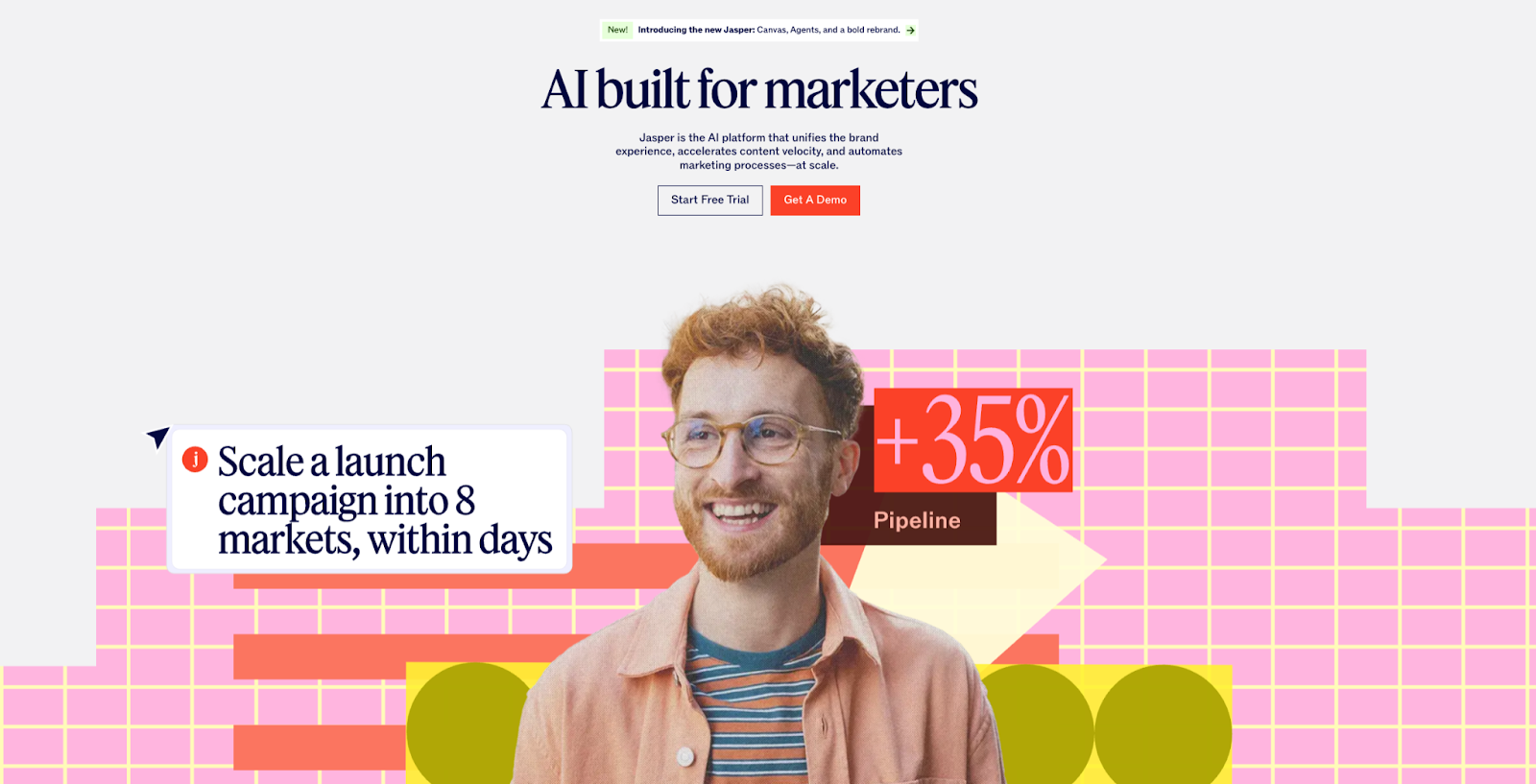
Jasper Business’s Top Features
- Multi-Brand Voice and Style Guide Integration: Jasper Business allows marketing teams to embed multiple brand voices, tone styles, and audience profiles into the AI.
- Custom Workflows and Dynamic Templates: Jasper Business supports creating custom workflows and reusable templates that automate repetitive tasks while adhering to brand compliance.
- Dedicated Support and Account Management: Enterprise customers get access to dedicated account managers and premium customer support, facilitating onboarding, training, and ongoing success.
- Wide Content Format Support: Jasper Business supports the creation of various content forms essential for marketing and offers SEO optimization integration (e.g., Surfer SEO).

Pricing
Jasper Business offers custom pricing; you’ll need to talk to Jasper’s sales team for a quote, but here’s what’s included:
- Everything in the Pro plan
- Unlimited content creation.
- Custom workflows and templates.
- AI Agents built for marketing.
- API access for integrations.
- Multi-brand voice management.
- Advanced admin tools and permissions.
- Dedicated support and account manager.
- Flexible, secure deployment.
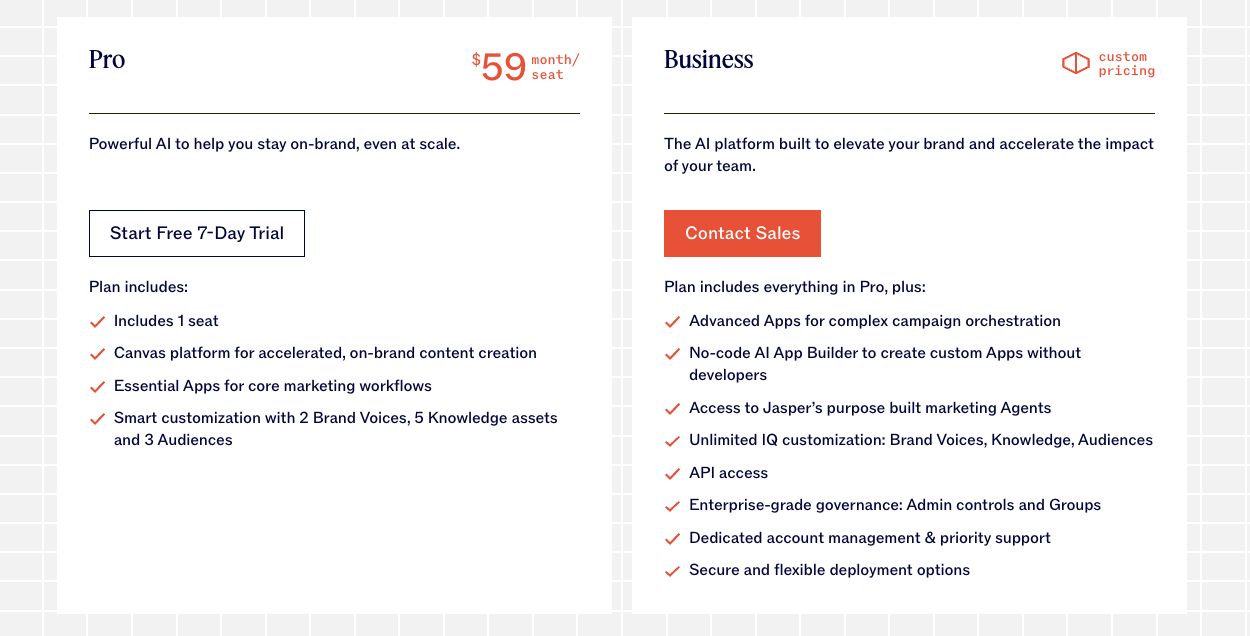
Pros and Cons
✅ Great for teams that need to manage multiple brands or clients in one place.
✅ Lets you set clear brand rules so every piece of content stays consistent.
✅ Offers powerful admin and security features for larger organizations.
❌ It doesn’t include built-in image creation; you’ll need other tools for visuals.
❌ You’ll need time to learn and set up the advanced features.
8. Writesonic
Best for: Mid to large marketing teams that need SEO-focused content generation with multi-user collaboration and project management.
Similar to: Claude Teams, Jasper Business, Perplexity Enterprise Pro.
Who’s it for: Marketing teams or agencies producing content at scale across multiple projects or clients.
Writesonic offers AI-powered content creation combined with an SEO and AI search visibility platform optimized for marketing teams. Their Advanced plan is designed for scaling teams, supporting multiple users and projects, with enhanced SEO tracking features and project scaling capabilities. Similarly, the Enterprise tier is tailored for large organizations, offering customizable user limits, legal and compliance reviews, dedicated training, and advanced admin controls.

Writesonic’s Top Features
- AI SEO Visibility & GEO Tracking: Monitor brand performance across AI platforms like ChatGPT, Perplexity, and Claude, and take actionable steps to improve rankings and citations.
- AI-Powered Content Generation: Automatically create optimized blogs, landing pages, ads, social media posts, and other marketing content at scale.
- Site Audits and SEO Fixes: Run multi-step SEO audits (60 for Advanced, more for Enterprise) to detect and fix technical SEO issues automatically.
- Project Scaling: Scale content production and optimize cross-domain marketing SEO campaigns.
- Customizable User Access: Especially on Enterprise, where you can set permissions, review workflows for legal approval, and scale your team as needed.
- API Access: Connect Writesonic to your existing content systems or marketing tools.
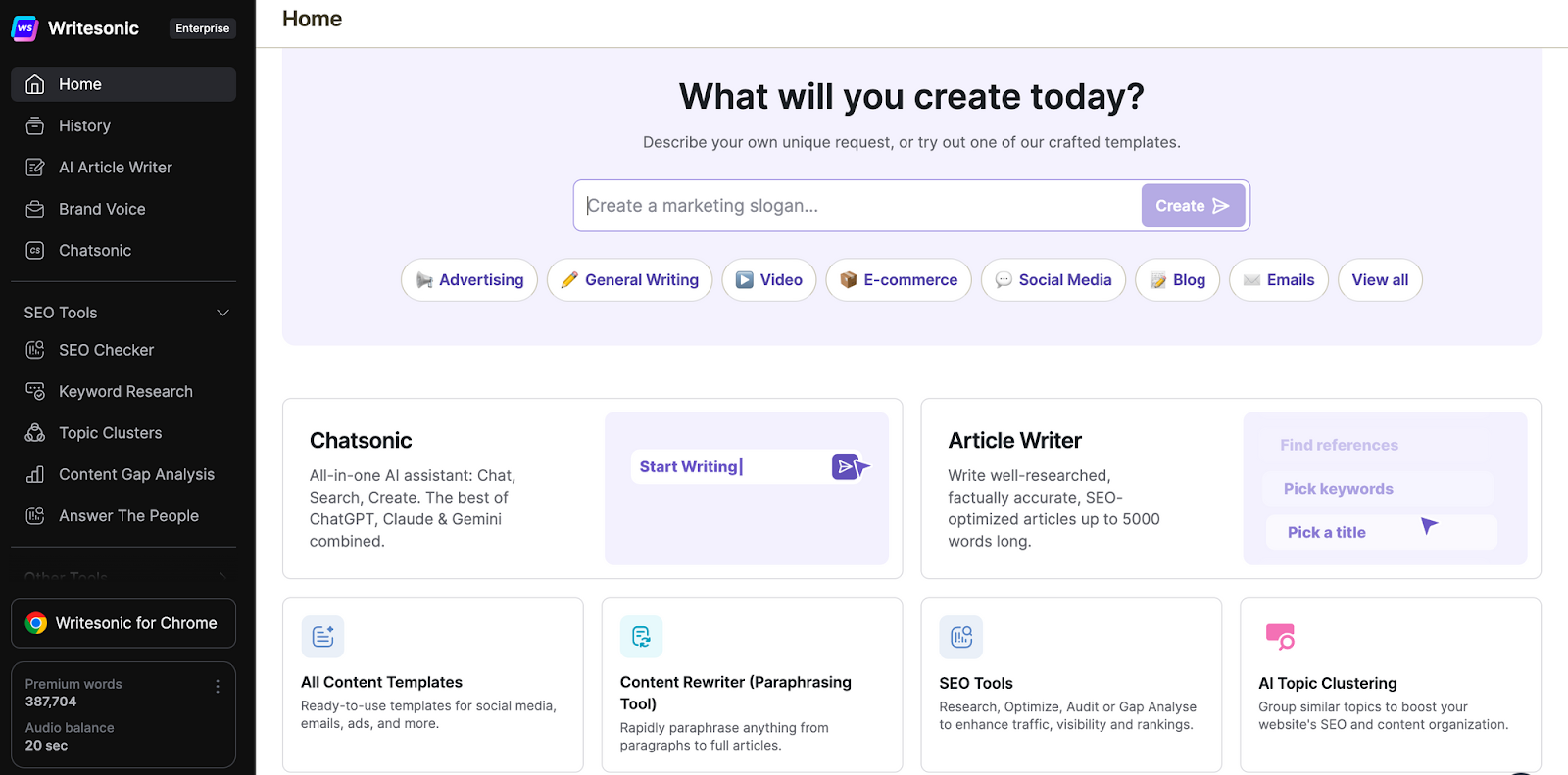
Pricing
Writesonic offers two pricing plans for marketing teams with increasing features and limits:
Pros and Cons
✅ Helpful for teams that already have some SEO knowledge and want to automate parts of it.
✅ Offers strong admin controls and approval workflows in the Enterprise plan.
✅ GEO tracking helps you understand how your content performs across AI search engines.
❌ Advanced and Enterprise plans can be expensive for small teams.
❌ New users may need time to get used to the SEO and GEO tools.
9. TeamAI
Best for: Marketing, sales, and enterprise teams that need a shared AI access and agencies managing multiple clients and campaigns.
Similar to: Microsoft Copilot, Jasper, Writesonic.
Who’s it for: Teams that want to reduce costs compared to per-seat models and businesses looking to build custom AI agents without code.
TeamAI is a collaborative AI workspace built to cut down team-wide AI costs and simplify access to multiple large language models (LLMs). Instead of buying individual licenses, teams can work inside a shared space with unified access to models like GPT-4, Claude, Gemini, and DeepSeek.
The platform is designed to accelerate teamwork, knowledge sharing, and AI adoption with a flexible pricing structure for teams of all sizes, making it especially attractive for marketing teams needing both content generation and operational AI support.
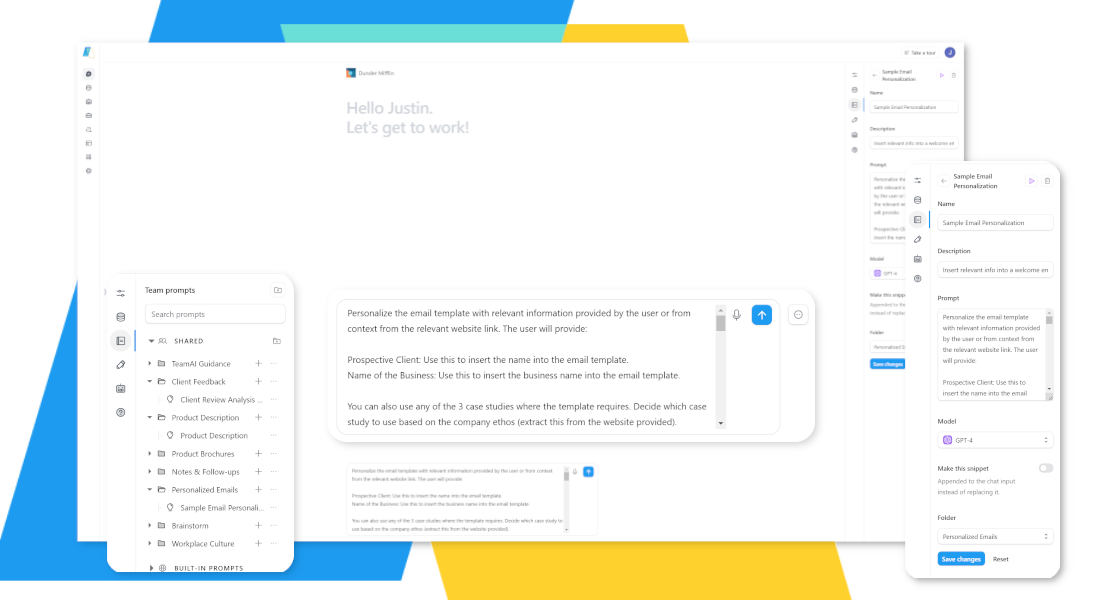
Team AI’s Top Features
- Multi-LLM Access: Instant use of multiple AI models like OpenAI GPT-4, Anthropic Claude, Google Gemini, and DeepSeek in a single workspace.
- Shared Workspaces: Collaborate collectively in AI workspaces with shared prompt libraries and workflows instead of individual logins.
- Custom AI Agents: Build no-code AI assistants reflecting your business rules, sales processes, and content guidelines; deploy them anywhere in the organization.
- AI Data Hubs: Upload internal documents, campaign decks, or research files for AI-powered search, analysis, and context-aware assistance.
- Automated Workflows: Create task automation sequences AI will follow end-to-end for marketing, sales, or customer support functions.
- Embedded Chatbots: Customer-facing AI assistants trained to provide on-brand support and engagement.
- Prompt Library: Access a library of 500+ pre-built prompts customizable and shareable at organizational level.
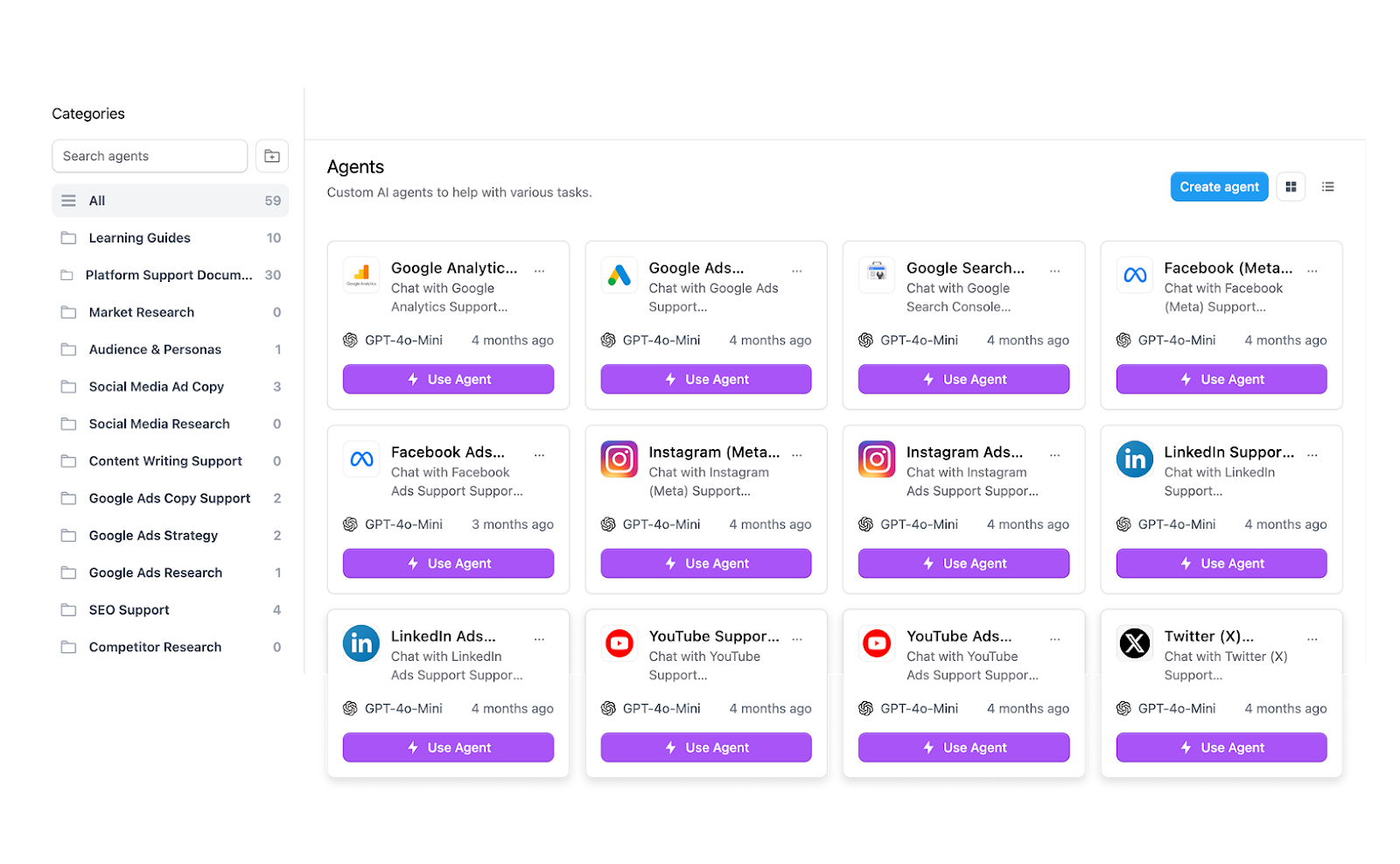
Pricing
TeamAI uses workspace-based pricing instead of per-user billing, making it cost-effective for large teams. Here’s how it is priced:
- Starter ($21.25 per month for upto 10 users): 5,000 messages, 10 custom agents, 10 data stores, and limited workflows.
- Professional ($126.65 per month for upto 25 users): 20,000 messages, 25 custom agents/plugins, and 10 automated workflows.
- Enterprise ($721.65 per month for upto 20,000 users): Unlimited agents/workflows, and advanced security/admin tools.
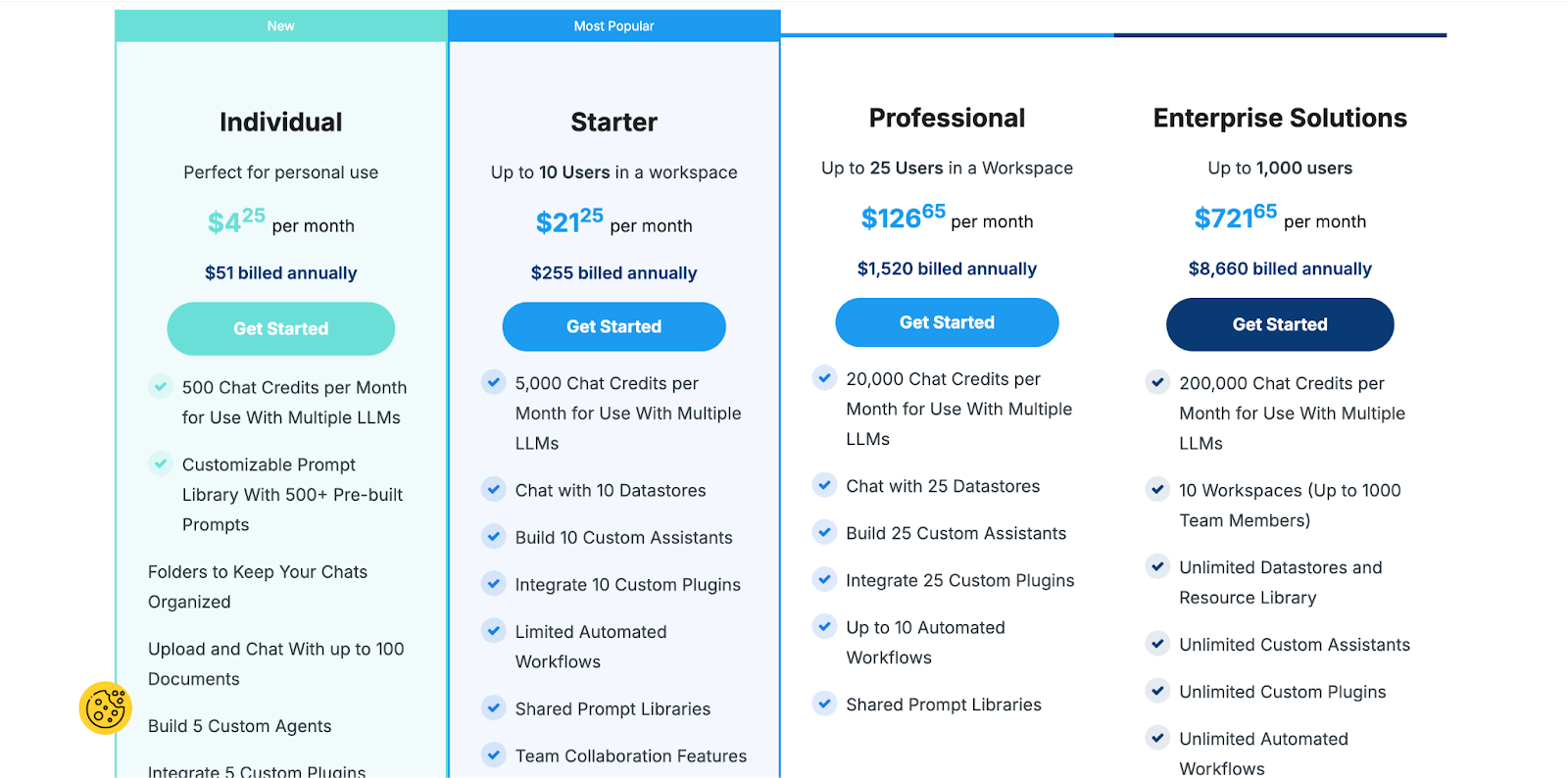
Pros and Cons
✅ Shared workspace pricing saves significantly over per-seat models.
✅ Supports multiple LLMs in a single, unified interface.
✅ No-code AI agent creation tailored to your company’s processes.
❌ Setup and training may take time for teams new to AI workflows.
❌ No public API (as of now), limiting advanced integrations.
10. Deepseek
Best for: Teams and businesses that need powerful AI but want to keep costs low. This works especially well if you’re budget-conscious and want flexible, pay-as-you-go pricing.
Similar to: Google Gemini, Llama 3, Rytr.
Who’s it for: You’ll benefit from DeepSeek if you’re on a marketing team, managing ad copy, content creation, or market research and need AI that can both chat and reason.
DeepSeek gives you access to two powerful AI models from an open-source platform. One model is built for chat-based tasks, like drafting emails or writing blog posts. The other handles deep reasoning, like analyzing data or making market forecasts.
What makes it stand out is its pricing: you pay only for the text you send and receive (using a “token” system), and costs are much lower than comparable AI services. You get both affordability and high performance, especially if you frequently reuse prompts, which helps lower your spending even more.
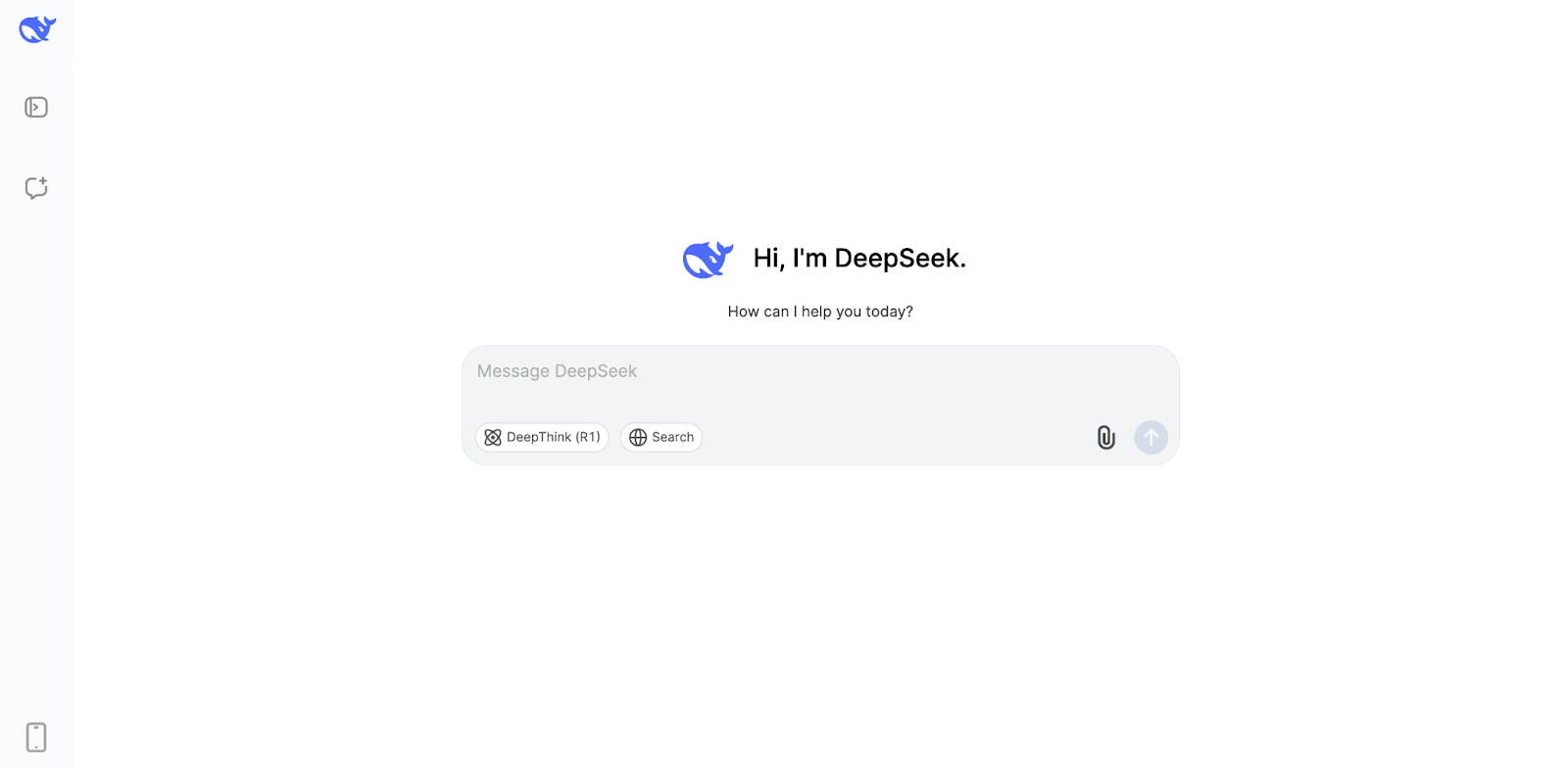
Deepseek’s Top Features
- Mixture of Experts (MoE) Architecture: Efficient use of computational resources while maintaining performance.
- Dual Model Offering:
- V3 (Chat) for conversational content like messaging or campaign copy.
- R1 (Reasoner) for complex tasks like data analysis or market insights.
- Open Source Licensing: You can view, customize, or host the model yourself, great if you want control or local deployment.
- API Access: Works well with custom apps, marketing tools, or internal systems.
- Multi-mode AI Tasks: Can handle text generation, summarization, Q&A, and analysis.
- Support for Large Contexts: Useful for processing large campaign briefs, long documents, or batch SEO analysis.
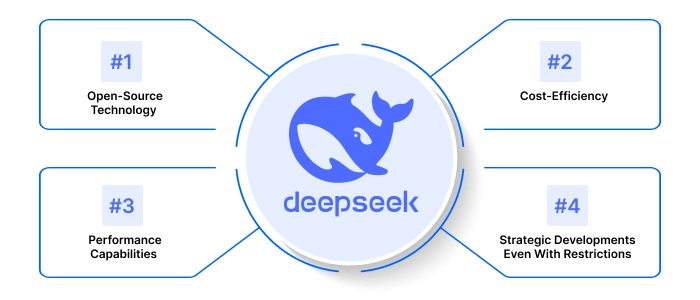
Pricing
DeepSeek offers flexible access through both free and paid options. You can start using DeepSeek-V3 for free directly from your browser, or download the open-source model for local, commercial use.
Paid plans are based on token usage, where costs vary depending on whether the system serves responses from its cache:
- DeepSeek-Chat Model: Starts at $0.07 per 1 million tokens (for cache hits) and goes up to $0.28 per 1 million tokens (for cache misses).
- DeepSeek-Reasoner Model: Starts at $0.14 per 1 million tokens (for cache hits) and can go up to $2.19 per 1 million tokens (for cache misses).

Pros and Cons
✅ Very affordable pricing, especially compared to per-seat or subscription models.
✅ Tokens cache cuts costs on repeated queries.
✅ API support makes integration straightforward for marketers with technical support.
❌ There’s no polished app or UI; it is more developer-focused, so you may need help setting it up.
❌ The open model raises concerns about data security and compliance for some users.
Final Thoughts: Why Team-GPT Could Be Your Ideal ChatGPT Teams Alternative
If you’re looking for a purpose-built alternative to ChatGPT Teams that focuses on structured collaboration, access control, and multi-model flexibility, Team-GPT is the best option.
Unlike general-purpose tools, it’s designed for teams that want more than just shared chat access, offering version history, workspace-level permissions, centralized projects, and support for multiple models like GPT-4, Claude, and Mistral.
It scales well for both small and large teams with simple, affordable pricing and robust admin features. Whether you need audit logs for compliance, role-based access, or real-time team collaboration inside the same threads, Team-GPT delivers on functionality without adding complexity.
If your team relies heavily on AI for internal workflows, knowledge sharing, or prompt management, Team-GPT is built with those exact needs in mind. Book a demo!
Read More
- DeepSeek vs. ChatGPT vs. Team-GPT: DeepSeek outperforms in advanced Chinese NLP, ChatGPT delivers versatile conversational AI, while Team-GPT stands out with real-time collaboration, multi-model access, and organized project workflows for teams.
- Copilot vs. ChatGPT vs. Team-GPT: Microsoft Copilot is ideal for productivity inside the 365 ecosystem, ChatGPT excels at solo ideation and problem-solving, whereas Team-GPT is built for team-wide collaboration, prompt sharing, and streamlined content creation.
- Team-GPT vs. ChatGPT for Teams: While ChatGPT Teams works well for individuals under a shared billing plan, Team-GPT offers true team functionality with model flexibility, shared workspaces, and granular project control.
- Perplexity vs. ChatGPT vs. Team-GPT: Perplexity delivers fast, cited research results, ChatGPT offers broad conversational capabilities, and Team-GPT combines collaboration, knowledge organization, and multi-model workflows in one shared platform.
- Microsoft 365 Copilot vs. Team-GPT: Copilot integrates seamlessly with Microsoft apps for task automation, whereas Team-GPT provides a dedicated AI workspace for brainstorming, writing, and organizing knowledge across multiple models.
- Team-GPT vs. Copy.ai: Copy.ai specializes in generating marketing content with basic collaboration, while Team-GPT enables full AI-powered teamwork across projects, models, and creative workflows.

